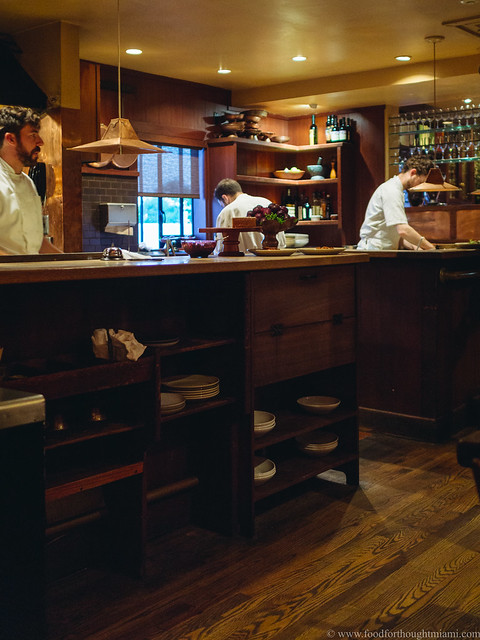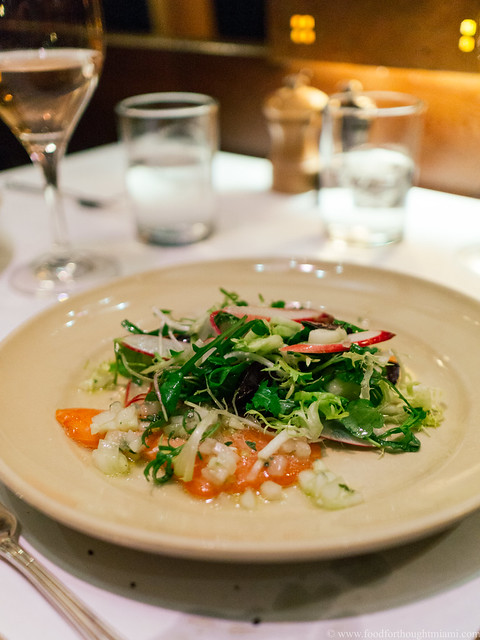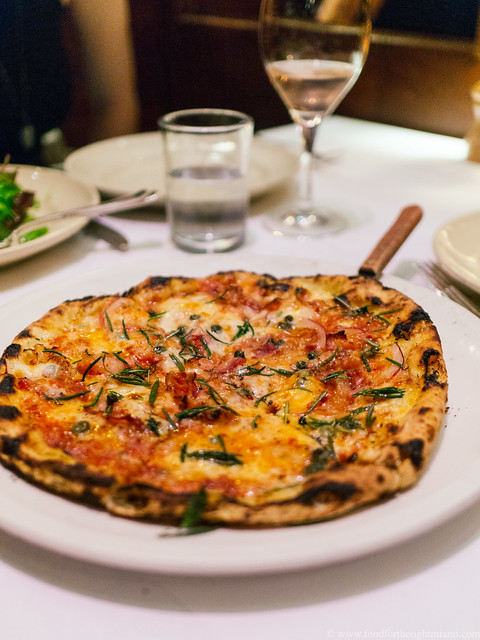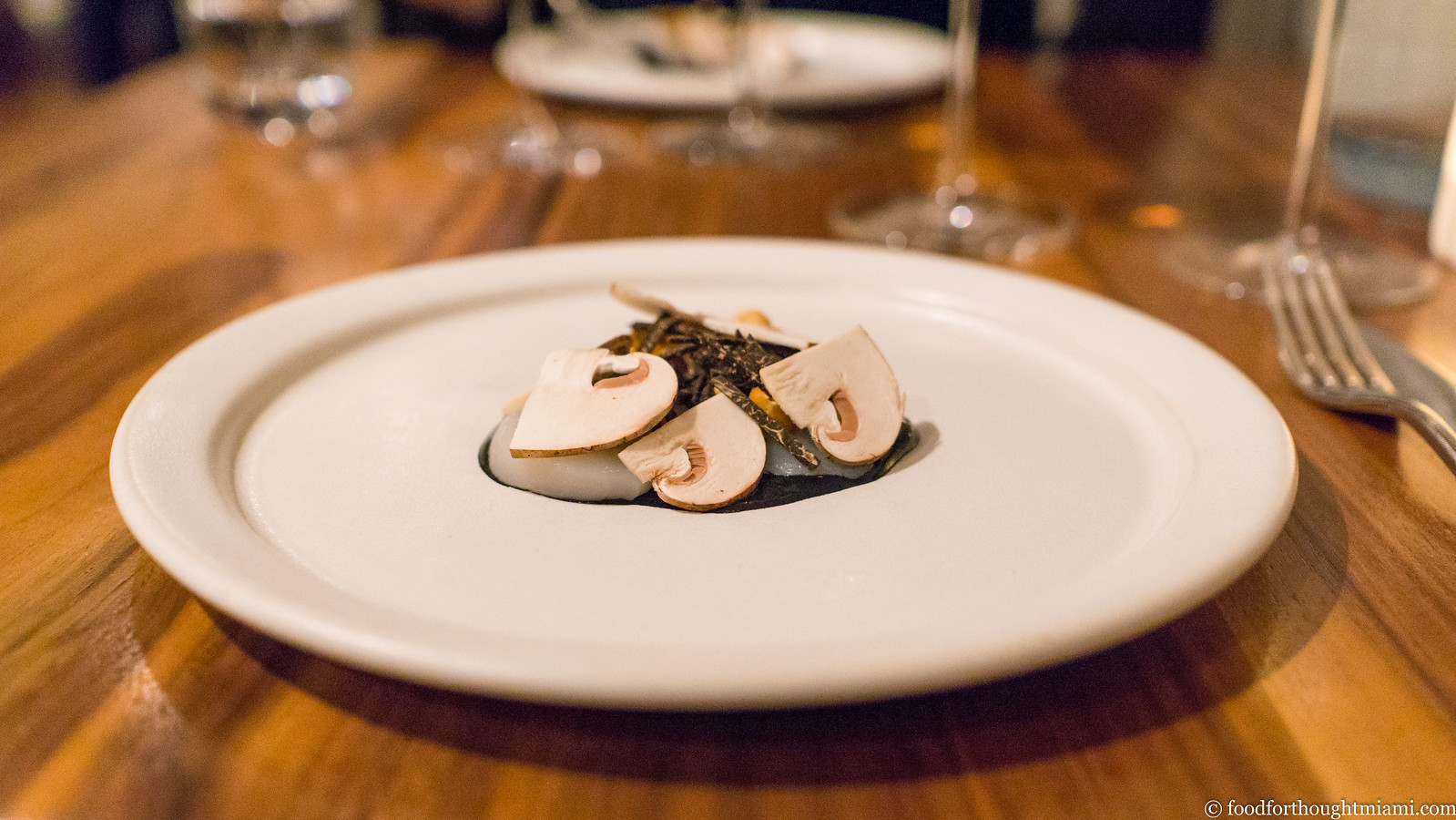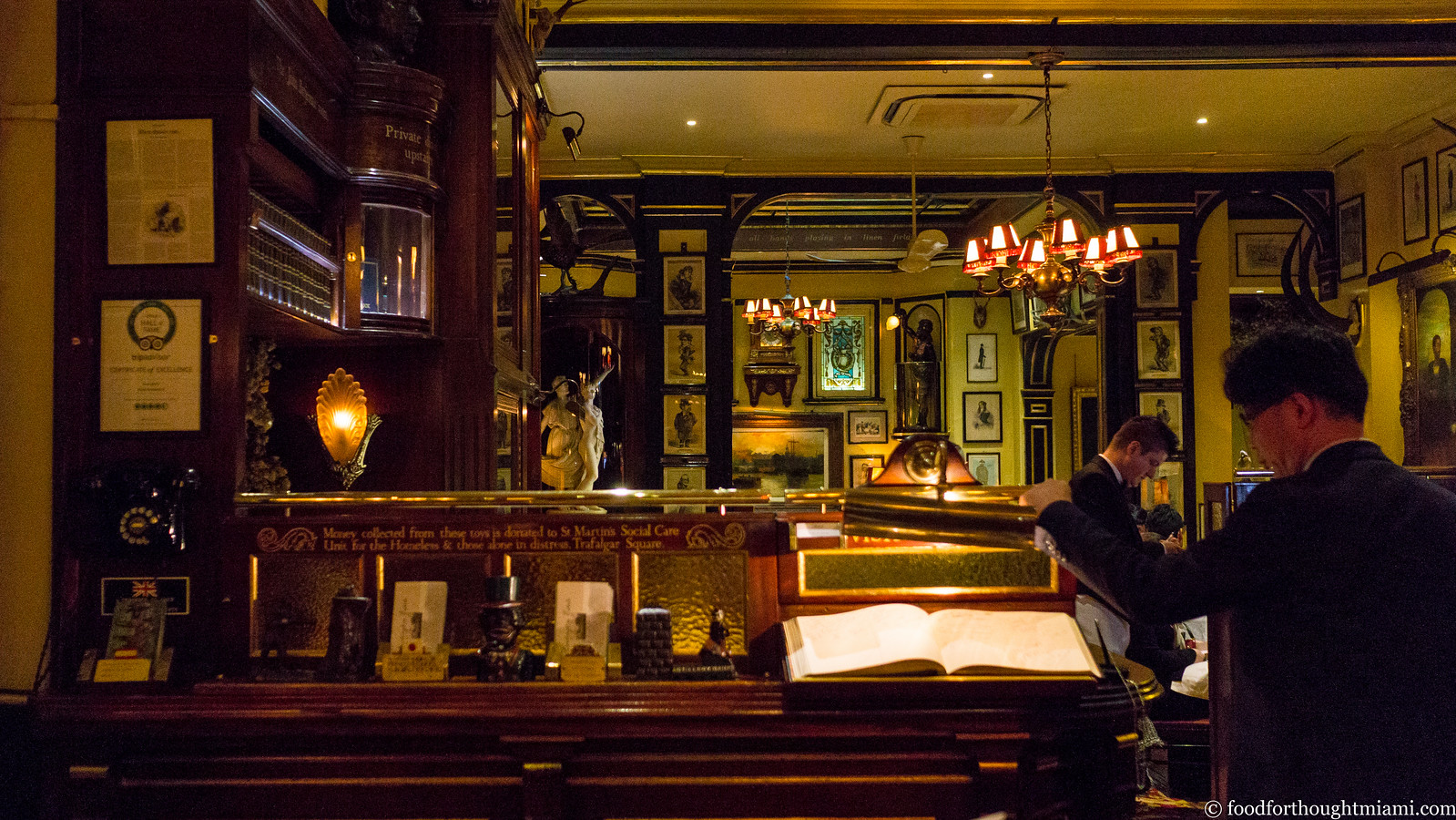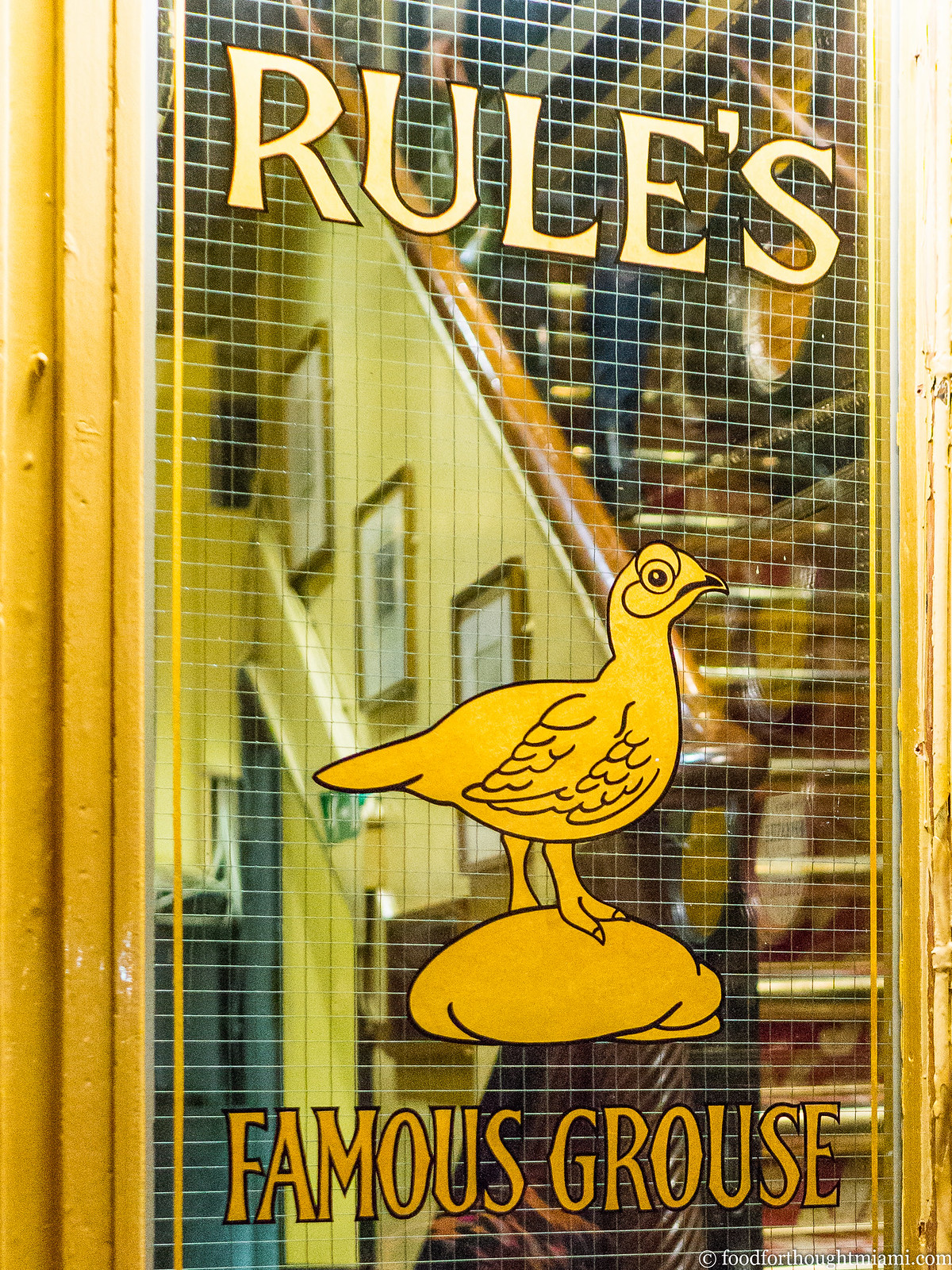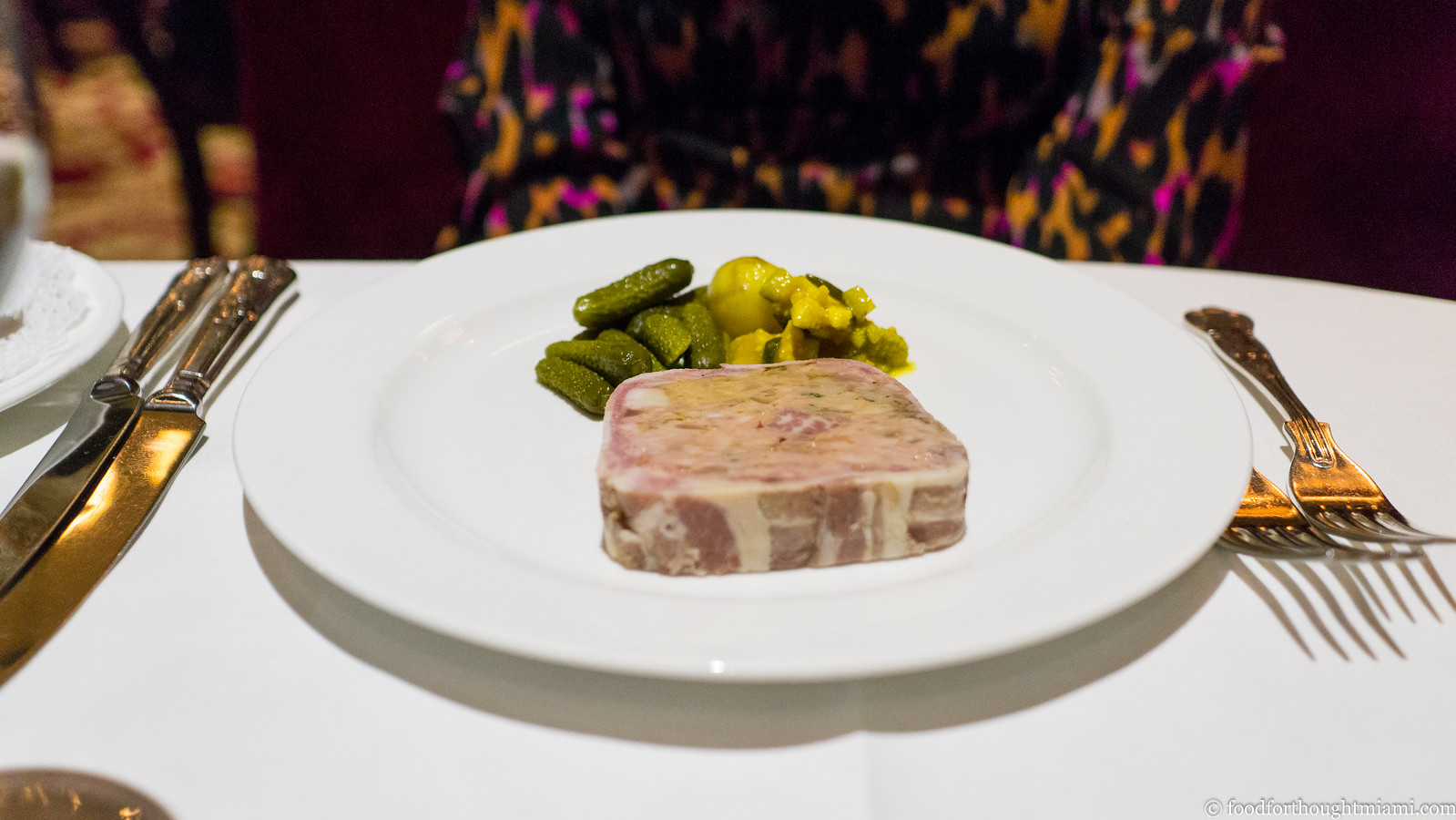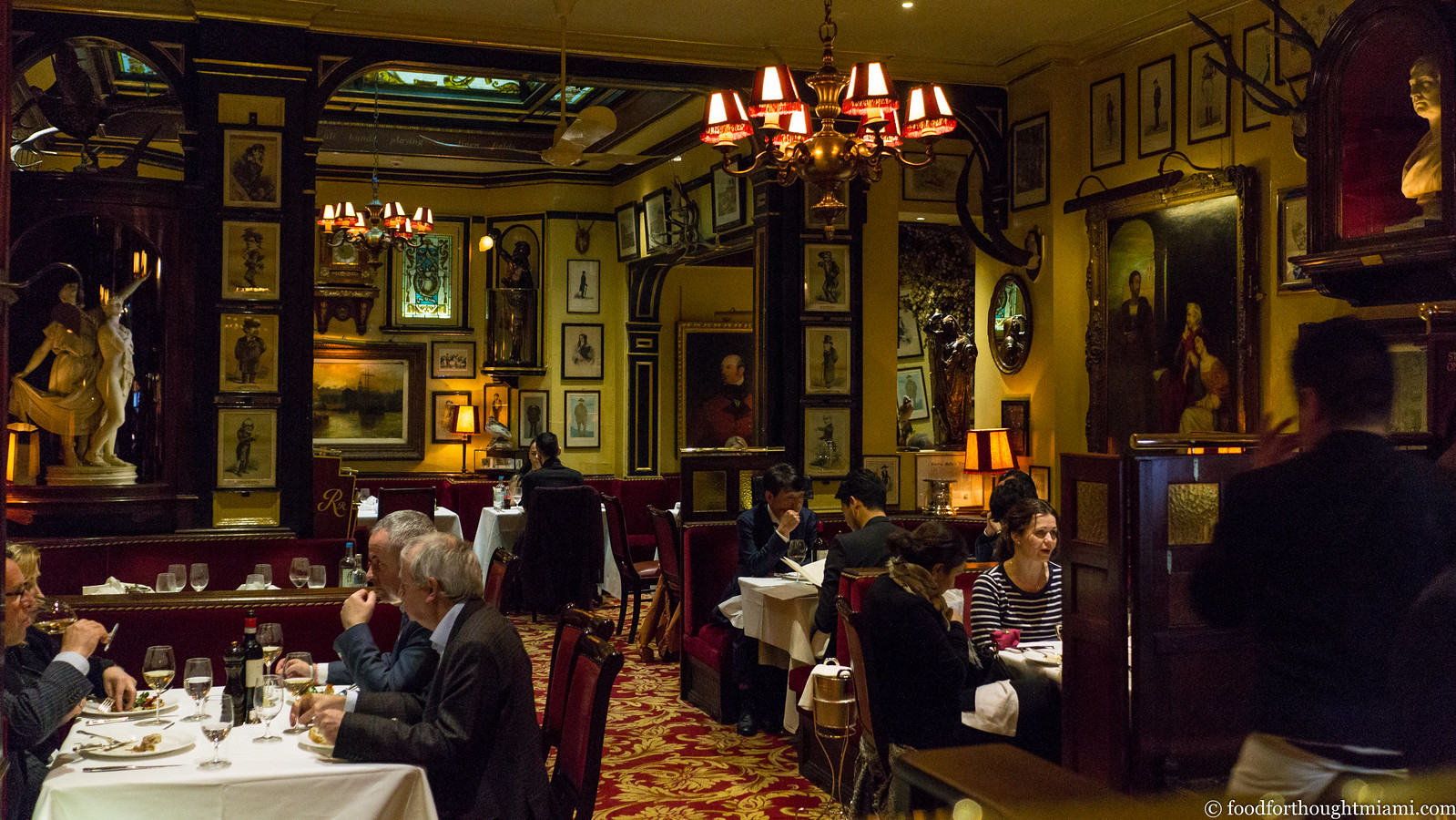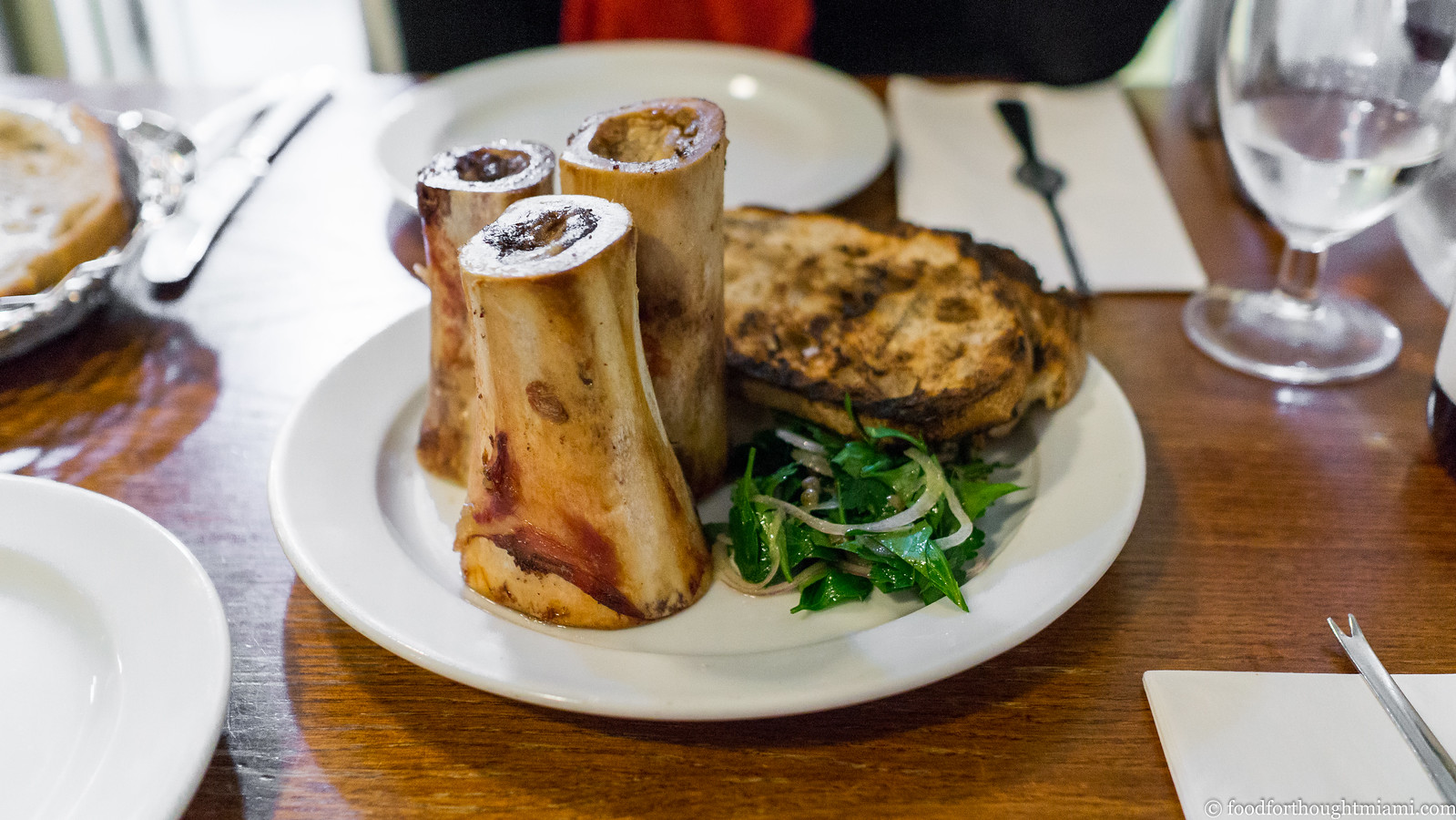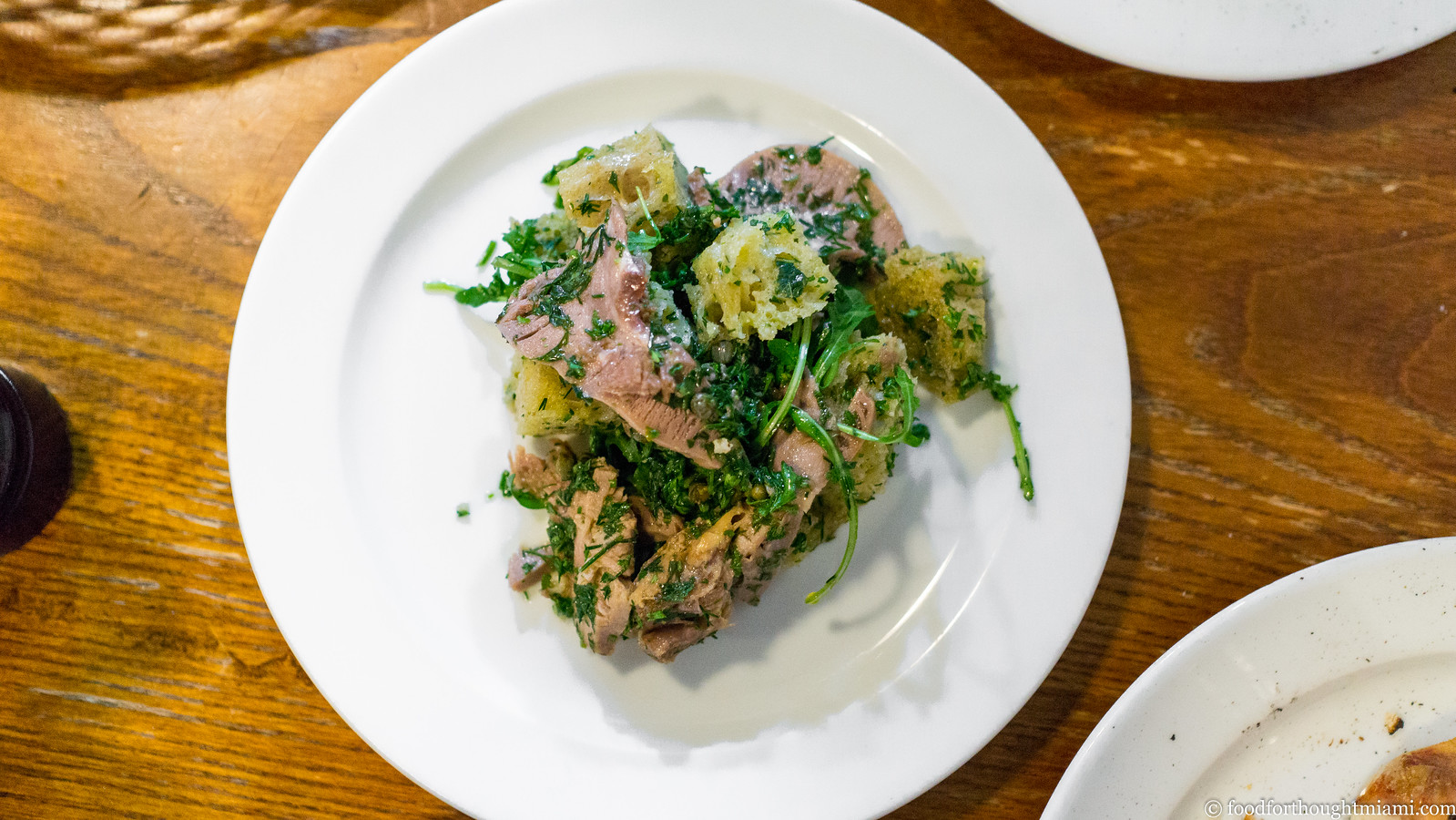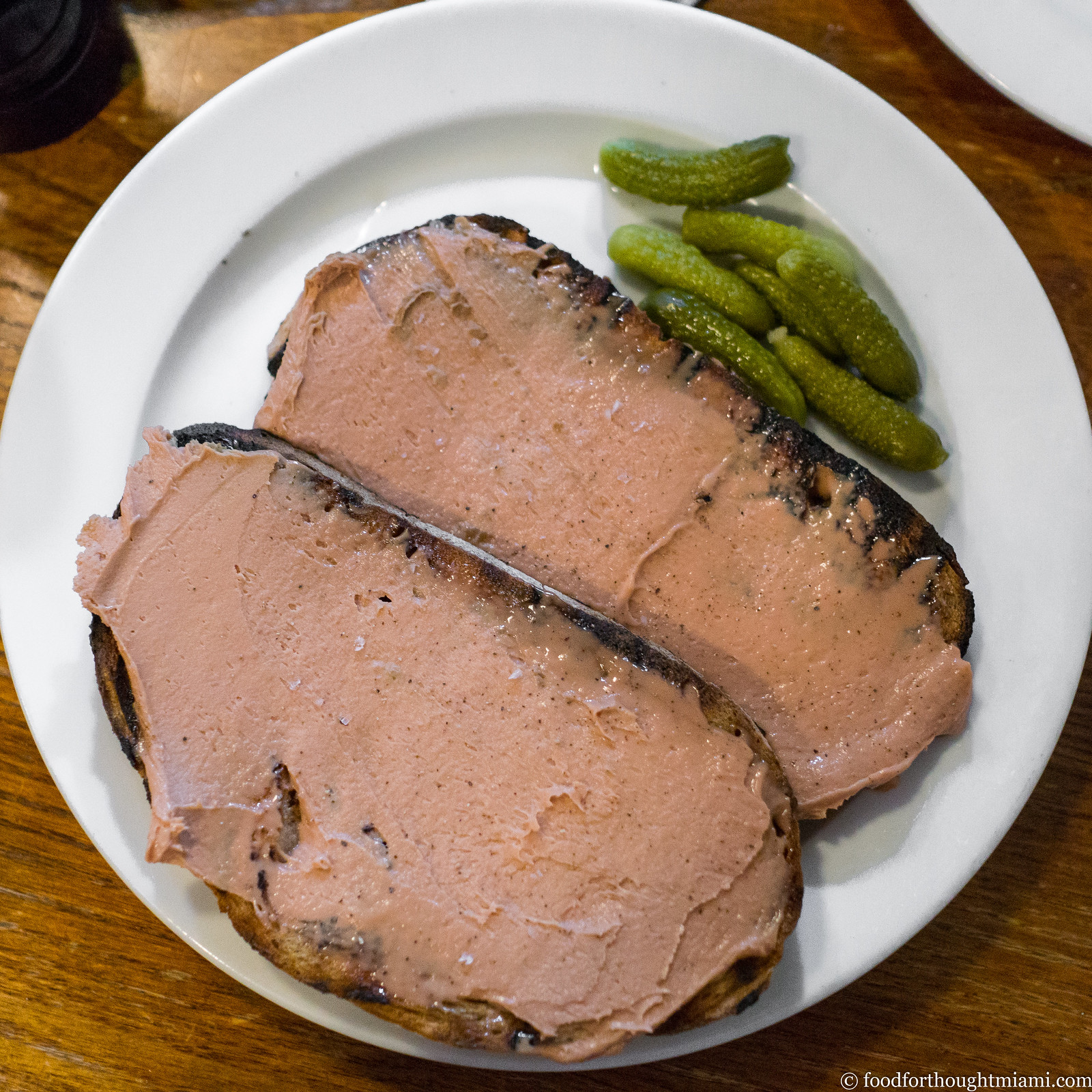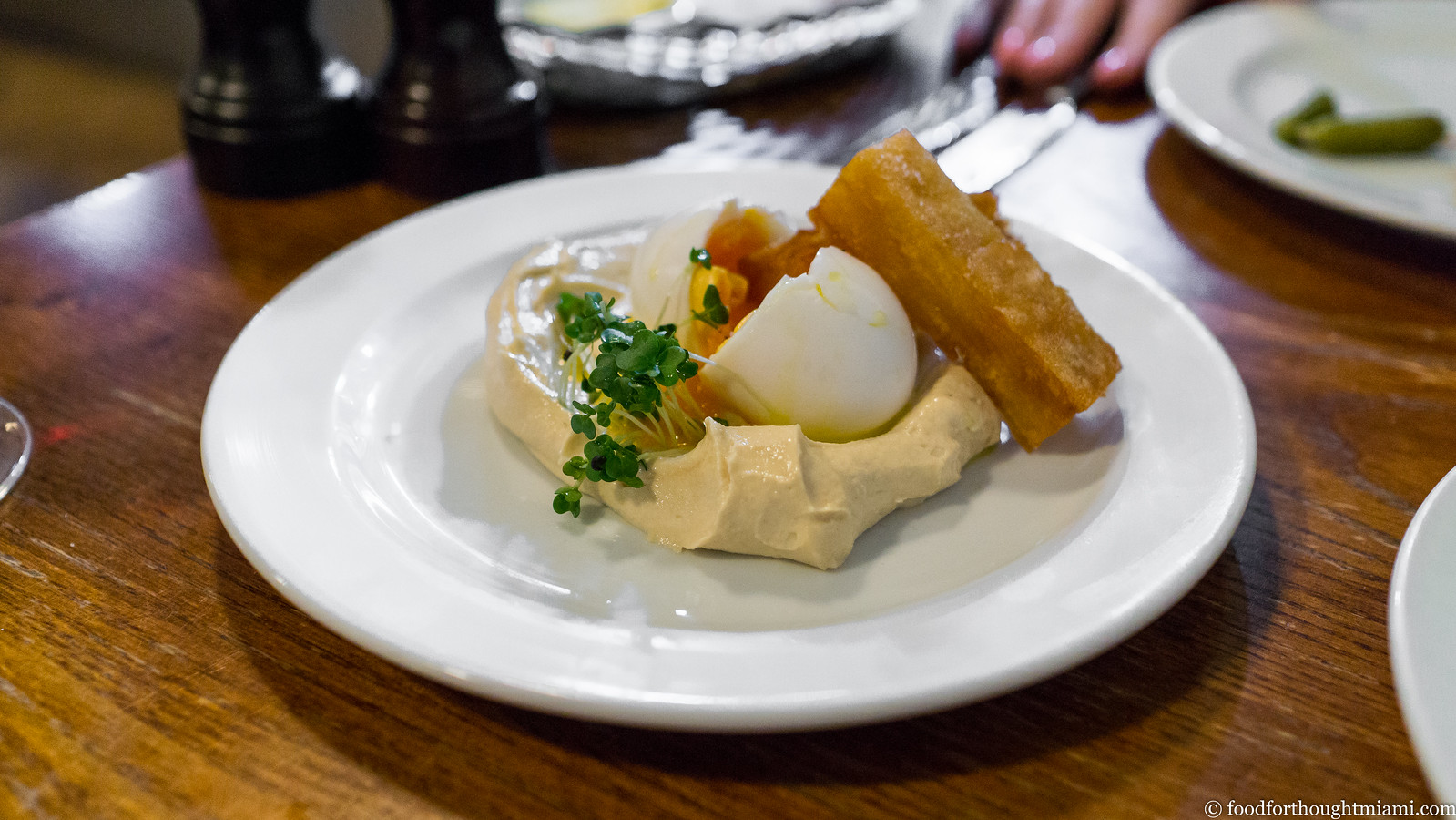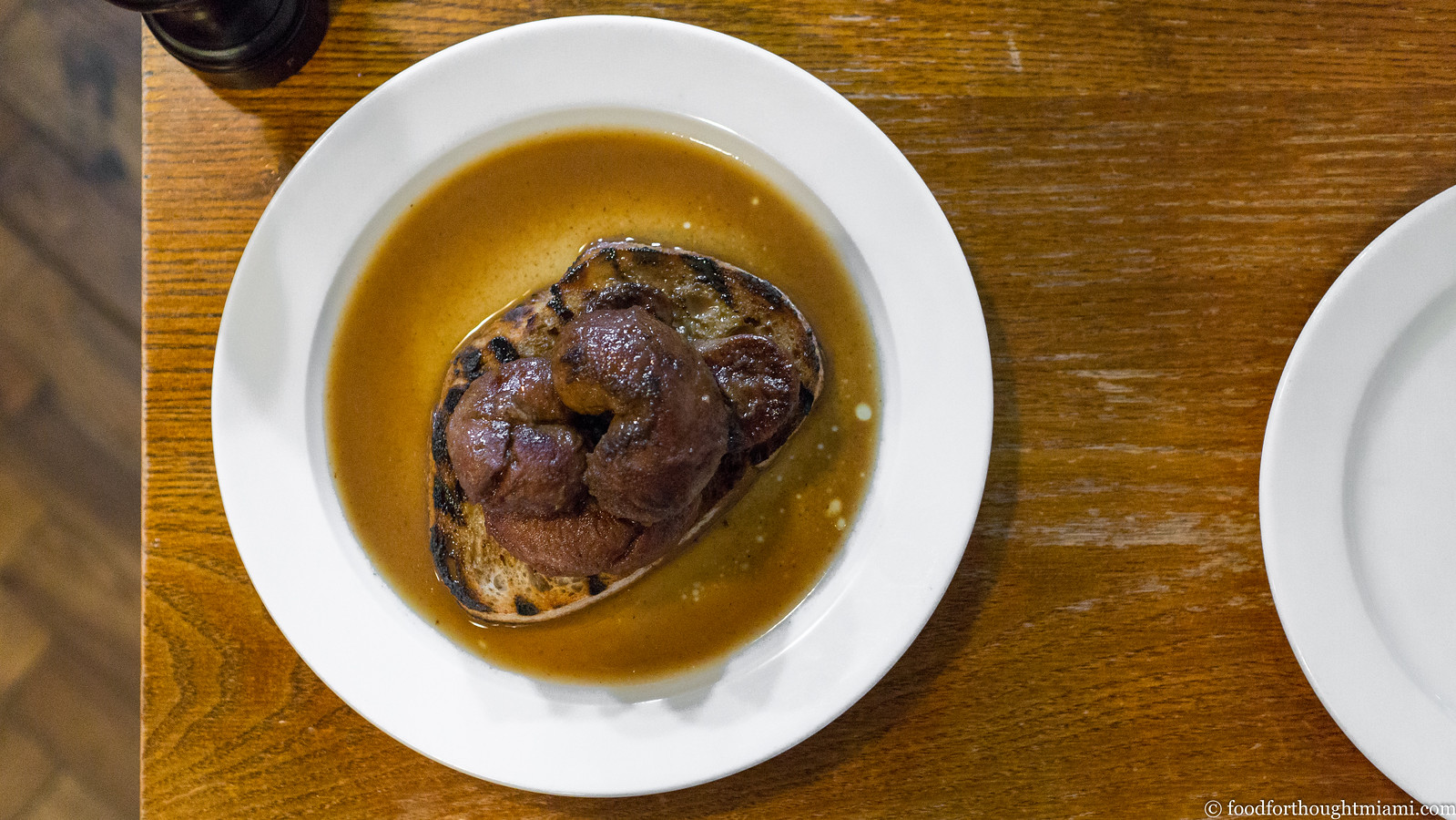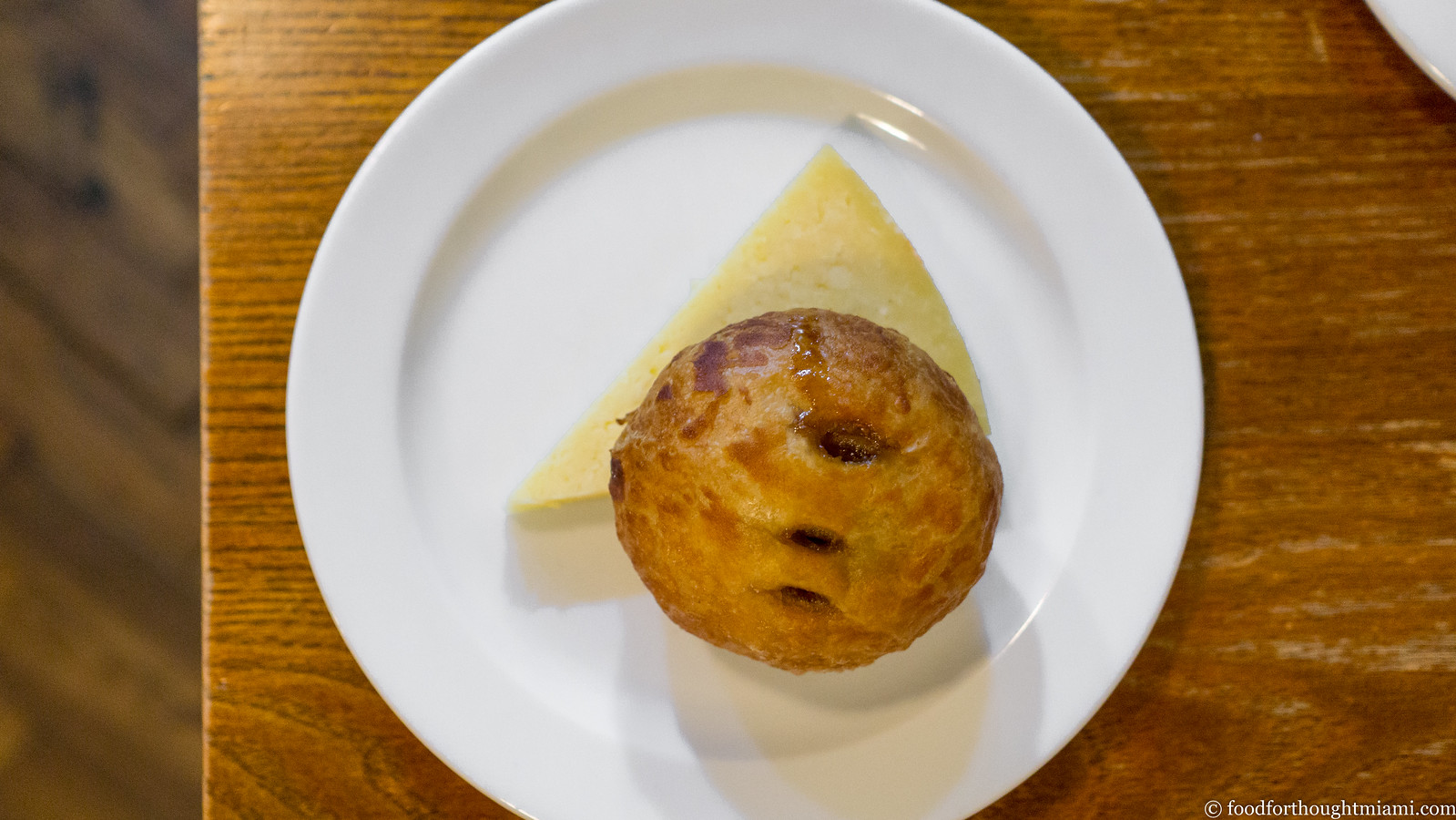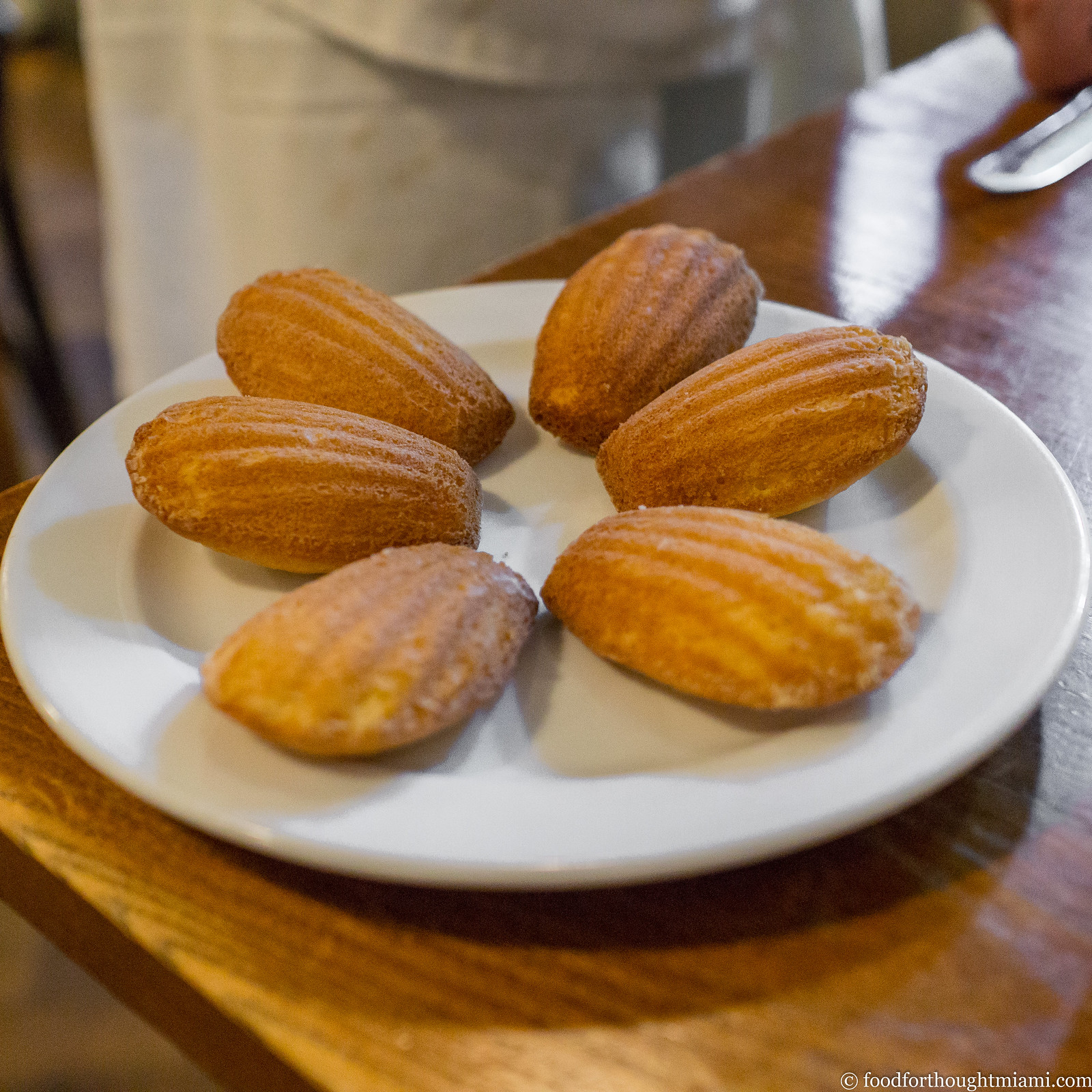Some places aren't just restaurants; they're institutions. Chez Panisse certainly falls in that category. Its founder, Alice Waters, is widely regarded as the patron saint of the "farm-to-table" movement: the restaurant, which she opened in 1971, made the sourcing of local ingredients a cornerstone long before that term was commonly used, much less beaten to death.[1] And generations of restaurants since have followed suit.
My last visit to Chez Panisse must have been about twenty years ago.[2] It doesn't seem to have changed much at all, even though the two-story Arts and Crafts style space got a major facelift about five years ago after a fire. (No doubt it helped that the architect who first designed the restaurant, Kip Mesirow, was responsible for the renovation as well.) Downstairs is the original "restaurant," which still serves a three- or four-course prix fixe menu in a sort of country French idiom that changes on a daily basis. Upstairs is the "café," opened in 1980, which offers an à la carte menu and a somewhat more casual feel. Maybe the biggest change is that both upstairs and downstairs now have open kitchens, whose wood cabinets and shelves blend so seamlessly into the rest of the space that it really does feel a bit like eating in someone's home.
(You can see all my pictures in this Chez Panisse flickr set.)
Remarkably for a restaurant that's been around for nearly half a century, Chez Panisse doesn't feel particularly dated. Indeed, aside from the farm-to-table thing, there are at least a couple other facets of contemporary dining culture where I think Chez Panisse was way ahead of the game, including those daily changing menus, and the combination of high-end food in a more informal setting. If I told you that a rustic-looking place, with a charcoal grill and wood burning oven, serving food straight from the farms, fields and docks had just opened in the East Bay, you'd probably think it was right on trend. It's a testament to the restaurant's outsize influence; and, I suppose some would say, to the stagnancy of what's come to be known as "California Cuisine."[3]
There's a reason for the genre's staying power, though: when it's done right, it's still very good, especially in Northern California, which produces some of the greatest raw ingredients on the planet. And Chez Panisse is still doing it right.
We opted for the café over the restaurant. Although it may lack the dinner party vibe downstairs, the food still captures that "of the moment" feel: while the format of the à la carte menu stays largely the same, the particular pieces change from day to day, and sometimes even from lunch service to dinner.
Some of the highlights from our visit:
A simple salad of crisp, perky gem lettuce, dotted with juicy, sweet sungold tomatoes, napped with an assertively salty, funky anchovy dressing.
A crudo of wild California king salmon with cucumbers and green coriander, accompanied by a wispy salad of greens, herbs and slivered radishes.
A pizzetta cooked in the wood oven, topped with pancetta, hot peppers, capers and fresh rosemary – great to order as an appetizer "for the table."
(continued ...)
Showing posts with label further afield. Show all posts
Showing posts with label further afield. Show all posts
Monday, July 9, 2018
Friday, January 12, 2018
best dishes of 2017: part 3
We left off Part 2 of my "Best Dishes of 2017" (you can see Part 1 here too) in San Francisco. We stay in the Bay Area for Part 3 here, with a trip up to Healdsburg, then detour to Las Vegas, swing back to the east coast for a quick trip to Boston, then back home before ending the year in Santa Fe, New Mexico. As always, the "best" here is meaningless – this is just a compilation of some personal favorites from among several great meals over the course of the year.
Our summer getaway found us on the West Coast, a trip which included a couple days in Healdsburg. The wine country in the northern reaches of Sonoma County is among my favorite places on earth, and now it has a restaurant to match the beauty and bounty of the area: Kyle Connaughton's SingleThread (see more pictures in this SingleThread Farm flickr set). SingleThread is about as fully realized a vision of the Japanese combination of kaiseki dining and ryokan as you'll find outside of Japan: a restaurant, supplied by its own nearby five-acre farm (run by spouse Katina Connaughton) plus contributions from neighboring farmers, fishermen and foragers, with a small, luxurious inn on premises (we regretfully didn’t stay at the inn, instead renting a house up the Russian River so we had room for the whole family and some friends).
This was, from start to finish, just a magical meal – refined and beautiful and flavorful, intimately expressive of season and place.
After a glass of bubbly and a platter of snacks on the rooftop garden terrace, we were brought back inside to the dining room and greeted with a spread that could do double duty as a centerpiece. There’s maybe a dozen different items laid out across the table, interspersed among an arrangement of branches and blooms. I won’t try to recount everything here, and in any event the contents vary from day to day and season to season like the "hassun" course of a kaiseki meal, but I particularly recall the cold slivers of geoduck in a neon peach-hued stone fruit gelee; a tart, bright, green tomato gazpacho; a creamy corn panna cotta with an accent mark of fermented cucumber; silky purple baby eggplant agebitashi with a sesame and plum curd; an intensely rich mousse of potato and salt cod; ripe, fat mulberries from nearby Middlteton Farm. And it's all as delicious as it is beautiful.
From an ornate tapestry of dishes to bare-bones simplicity: wild king salmon, caught in Half Moon Bay, smoked in an ibushi-gin (a type of donabe, or Japanese stone pot, which are something of an obsession at SingleThread), swimming in a vinaigrette of negi (Japanese scallion) bolstered with the magic of shio koji, garnished with a dollop of char roe and a tiara of finely slivered myoga (young ginger) and radish. When I had the smoked salmon at Willows Inn, I was pretty certain that would be the best salmon I'd ever eat in my life. Now I'm not so sure.
So often, foie gras gets fruity accompaniments as a foil for its richness. Here, instead, Connaughton goes vegetal. A disk of poached foie, with a texture like cool butter, is awash in a "tea" of last year's tomatoes, plus an assortment of radishes and their greens in various forms: fresh, preserved, dried. The peppery crunch of the radishes does the same job without the usual cloying sweetness. And then another bit of magic comes from an aged sake poured with it – again, a far cry from the customary sweet Sauternes – which magically pulls it all together, one of the most memorable pairings of the whole year.
I know, we're four deep into this list and we're still haven't left SingleThread. What can I say, it was pretty good. This bowl of Sonoma grains, bound in a luminous green nettle purée, garnished with kasuzuke pickled vegetables, a farro verde beignet, a bouquet of herbs, sprouts and petals from the garden, and a tableside drizzle of an intense aged rib cap jus (presumably a byproduct of the American wagyu served in the prior course), was served as the final savory item on the menu, in the same fashion that a rice dish usually acts as the anchor of a Japanese meal. It was incredibly gratifying and delicious, and felt like something of a summary and recapitulation of all that preceded it.
In October, a conference brought me to Las Vegas, where I always find time to visit Aburiya Raku (read my thoughts and see more pictures in this Aburiya Raku flickr set). It's the first place I tried fresh, house-made tofu and it's still one of my favorite places to order it. The pro move is to go half-and-half: a half order of the "Raku's tofu," served cold with garnishes of katsuobushi, chopped chives, minced ginger, and green tea salt; and a half-order of the agedashi tofu, fried, doused in an enriched dashi broth bobbing with little mushrooms, and topped with a dollop of ikura, shredded nori and more chopped chives. It's so good.
(continued ...)
 |
| mid summer in Sonoma - SingleThread |
This was, from start to finish, just a magical meal – refined and beautiful and flavorful, intimately expressive of season and place.
After a glass of bubbly and a platter of snacks on the rooftop garden terrace, we were brought back inside to the dining room and greeted with a spread that could do double duty as a centerpiece. There’s maybe a dozen different items laid out across the table, interspersed among an arrangement of branches and blooms. I won’t try to recount everything here, and in any event the contents vary from day to day and season to season like the "hassun" course of a kaiseki meal, but I particularly recall the cold slivers of geoduck in a neon peach-hued stone fruit gelee; a tart, bright, green tomato gazpacho; a creamy corn panna cotta with an accent mark of fermented cucumber; silky purple baby eggplant agebitashi with a sesame and plum curd; an intensely rich mousse of potato and salt cod; ripe, fat mulberries from nearby Middlteton Farm. And it's all as delicious as it is beautiful.
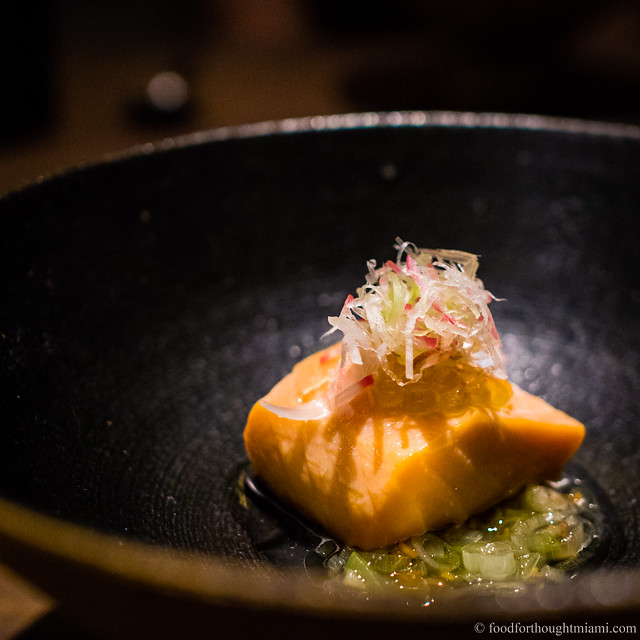 |
| wild king salmon ibushi-gin - SingleThread |
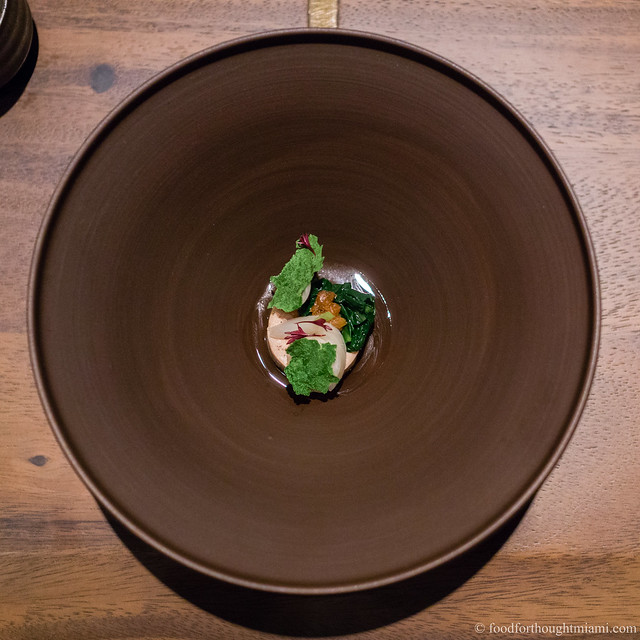 |
| poached foie gras, tea of last year's tomatoes - SingleThread |
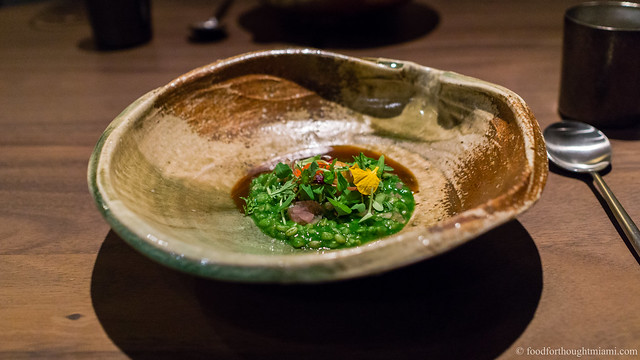 |
| Sonoma grains, nettles, kasuzuke - SingleThread |
 |
| agedashi tofu - Aburiya Raku |
(continued ...)
Monday, January 8, 2018
best dishes of 2017: part 2
We started last Friday with my "best dishes of 2017: part 1" – a compendium of personal favorites from the past year. We resume here with a highly pedigreed fried chicken sandwich, take quick treks through New York and Philadelphia, then detour back to Miami before swinging out to the west coast.
La Pollita was a short-lived Mexican-themed pop-up run from a trailer in the Midtown Garden Center by Luciana Giangrandi and Alex Meyer, who had previously worked at such places as Eleven Madison Park, NoMad, Scarpetta and Animal (read my thoughts and see more pictures in this La Pollita flickr set). The trailer is gone but the duo still seem to be kicking around Miami – I'm looking forward to what's next from them.
They've got a short list of tacos, served on fresh tortillas pressed from masa supplied by Miami masa maestro Steve Santana (of Taquiza), and the cochinita pibil I tried was very good. But the standout item was the fried chicken cemita. A hot, crispy, juicy tranche of fried chicken. A crunchy, vinegar-laced, herb-flecked cabbage slaw. A dollop of mashed avocado for some richness. A creamy, mildly spicy Valentina aioli. A sesame-seed flecked bun with just the right heft: substantial enough to be a meaningful component of the sandwich composition and to keep everything together until the last bite; but not so much as to overwhelm the stars of the show. It is just about perfect.
Hey, look, it's another great meal I never got around to writing about, at David Chang's Momofuku Ko, where the kitchen is run by Sean Gray (see more pictures in this Momofuku Ko flickr set). I never got to the original incarnation of Ko, legendary for its relatively affordable tasting menus, brutally uncomfortable stools, and impossible reservation system. In its newer digs down a tiny East Village street literally called "Extra Place," it retains some of its original punk sensibilities – the dining counter circling an open kitchen, the cooks presenting the dishes, the hip-hop soundtrack – but it's all pretty buffed and polished, kind of like a Gucci biker jacket.
The tasting menu still carries a couple of the original Ko classics – the "Ko egg" with caviar, crispy potatoes, onion soubise and sweet potato vinegar, the shaved frozen foie gras – but one of my favorites of the evening was a next generation Ko dish. It's deceptively simple: lobes of cold, sweet sea urchin, a scoop of chickpea hozon (a creamy, miso-like fermented paste), a drizzle of grassy olive oil. There's a subtle contrast of marine salty-sweet against earthy salty-sweet; of the delicately creamy texture of the uni against the thicker, peanut butter-y hozon, mirrored by the two orange shades on the plate. Pretty cool.
Another of my favorites at Ko was another deceptively simple composition: a dessert of cherry blossom dusted ice cream, served over creamy, sweet amazake (rice fermented with sake lees or koji), drizzled with a sauce of preserved cherries. It was simultaneously delicate but powerful, homey but elegant.
Olmsted, Greg Baxtrom's Brooklyn restaurant with a backyard garden that does double-duty as a pre- and post-meal hangout spot, has been much talked about (see more pictures in this Olmsted flickr set). In a way, all the chatter possibly sets expectations a bit too high, for what is just a really fun, delicious, casual, cozy, clever, relatively affordable neighborhood spot run by someone with chops honed at Alinea, Blue Hill at Stone Barns, Per Se, and Arzak. The menu changes all the time – they were on a yakitori bender during our visit, while also serving Hyderabadi inspired duck chakna, truffle-dusted rutabaga "tagliatelle," and simple but delicious sauteed soft-shell crab with pickled peppers and ranch dressing – but this one dish seems to have become a signature, and for good reason. A goldenrod hued carrot crepe serves as the platform for a salad of wispy slivers of multi-colored carrots, petals, sprouts, and sunflower seeds, concealing a rich clam and carrot stew underneath. It's unusual, unexpected, and delicious.
Daniel Rose's path was a somewhat unusual one. The Chicago native was inspired to move to Lyon to study cooking after taking classes at the American University in Paris. After years at the Institut Bocuse and apprenticeships around France, he opened his first restaurant – Spring – in Paris. It wasn't until a decade later that he returned to the States to open Le Coucou in New York with Stephen Starr (see more pictures in this Le Coucou flickr set). In a way, the place makes it feel like the last couple decades of dining history never happened. There are pressed white tablecloths and long wax tapers on the tables; the menu isn't a collage of small plates, but good old fashioned hors d'oeuvres, poissons et viandes (though a category of "gourmandises" features otherwise uncategorized indulgences like quennelles de brochet and veal tongue with caviar).
But the cooking is more precise, focused, bright and clean than the butter and cream laden juggernauts of the older era that Le Coucou otherwise invokes. And nowhere was that more evident than in a dish called "tout le lapin" (all the rabbit), a production which comes to the table in three different serving vessels (the picture here is better focused, but this one gives a view of the whole spread). The saddle is rolled and cooked and then sliced into rounds which are seared and browned, then napped with a loose sauce that takes the ferrous richness of rabbit offal, cuts it with an acidic vinaigrette, and brightens it with fresh mint. Alongside is a gratin dish of the rabbit's legs cooked down with soft, sweet onions. And finally, a pot au feu of the foreleg, in a golden broth bobbing with carrots and turnips. It's all wonderful.
(continued ...)
 |
| fried chicken cemita - La Pollita |
They've got a short list of tacos, served on fresh tortillas pressed from masa supplied by Miami masa maestro Steve Santana (of Taquiza), and the cochinita pibil I tried was very good. But the standout item was the fried chicken cemita. A hot, crispy, juicy tranche of fried chicken. A crunchy, vinegar-laced, herb-flecked cabbage slaw. A dollop of mashed avocado for some richness. A creamy, mildly spicy Valentina aioli. A sesame-seed flecked bun with just the right heft: substantial enough to be a meaningful component of the sandwich composition and to keep everything together until the last bite; but not so much as to overwhelm the stars of the show. It is just about perfect.
 |
| sea urchin, chickpea hozon - Momofuku Ko |
The tasting menu still carries a couple of the original Ko classics – the "Ko egg" with caviar, crispy potatoes, onion soubise and sweet potato vinegar, the shaved frozen foie gras – but one of my favorites of the evening was a next generation Ko dish. It's deceptively simple: lobes of cold, sweet sea urchin, a scoop of chickpea hozon (a creamy, miso-like fermented paste), a drizzle of grassy olive oil. There's a subtle contrast of marine salty-sweet against earthy salty-sweet; of the delicately creamy texture of the uni against the thicker, peanut butter-y hozon, mirrored by the two orange shades on the plate. Pretty cool.
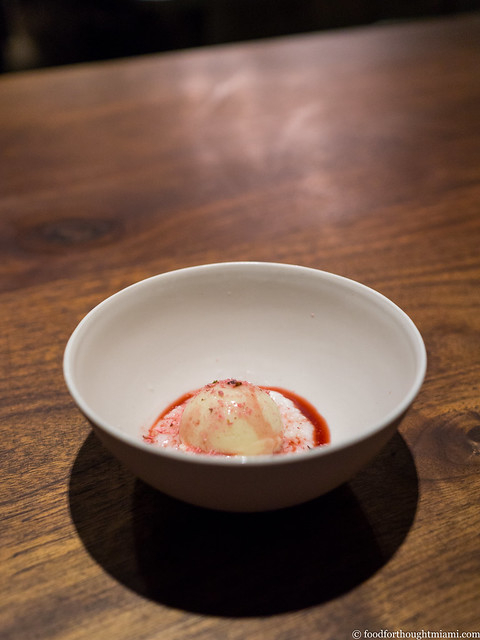 |
| cherry blossom, amazake - Momofuku Ko |
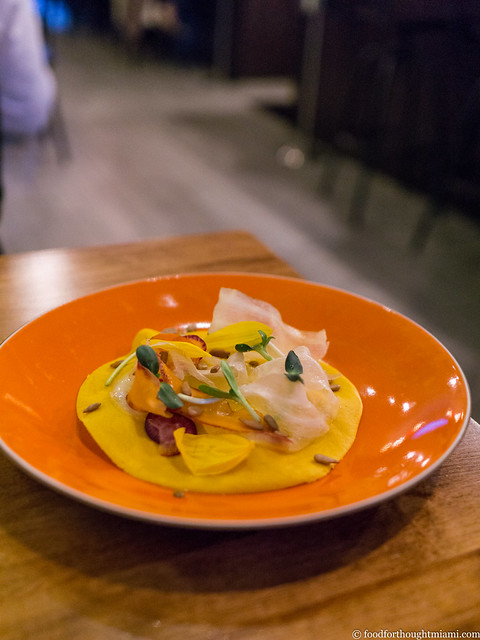 |
| carrot crepe, littleneck clam, sunflower - Olmsted |
 |
| tout le lapin - Le Coucou |
But the cooking is more precise, focused, bright and clean than the butter and cream laden juggernauts of the older era that Le Coucou otherwise invokes. And nowhere was that more evident than in a dish called "tout le lapin" (all the rabbit), a production which comes to the table in three different serving vessels (the picture here is better focused, but this one gives a view of the whole spread). The saddle is rolled and cooked and then sliced into rounds which are seared and browned, then napped with a loose sauce that takes the ferrous richness of rabbit offal, cuts it with an acidic vinaigrette, and brightens it with fresh mint. Alongside is a gratin dish of the rabbit's legs cooked down with soft, sweet onions. And finally, a pot au feu of the foreleg, in a golden broth bobbing with carrots and turnips. It's all wonderful.
(continued ...)
Friday, January 5, 2018
best dishes of 2017: part 1
I know, I know, you're supposed to do these "best of the year" wrap-ups before the year actually ends. Well, I'm just glad we've made it through to 2018, so I'm not going to sweat the timing all that much. Looking back, it was a somewhat odd year of eating for me. We traveled – London, Paris, New York, Philadelphia, Chicago, Boston, San Francisco, Las Vegas, Santa Fe – but they were all mostly short jaunts, a few days here and there that were over almost as soon as they began. Meanwhile, I'm feeling increasingly out of touch with developments here at home; the list of new Miami restaurants I haven't yet tried grows longer and longer.
Sometimes that's purposeful: just because it's new doesn't necessarily mean it's interesting or good. Sometimes it's geographically driven: one of the more interesting phenomena of the past year, to me anyway, is the abundance of independent restaurants opening outside of the usual trifecta of Wynwood, South Beach and Brickell. I'm thinking of places like Ghee in Downtown Dadeland, No Name Chinese and Shelley's in South Miami, Doce Provisions and Ella's Oyster Bar in Little Havana, Sherwood's Bistro in Little Haiti, Finka Table and Tap and Amelia's 1931 out west. Some of those are easier for me to get to than others, but those I've gotten to have provided some of the most interesting eating of the past year. And sometimes, let's be honest, inertia sets in.
As always, despite that word "best," I make no pretense of this being any sort of objective listing, only my personal favorites of the places I had the good fortune to visit in 2017. They are not ranked, but rather are listed here in roughly chronological order. For ease of digestion, I'll be breaking this up into three parts.
I wasn't sure Miami needed a second Bazaar restaurant from Chef José Andrés, but I'm glad we got another, and the seafood-focused menu at Bazaar Mar is sufficiently different from the original that they're both worthy of a visit (you can read my thoughts and see more pictures in this Bazaar Mar flickr set). There are lots of flashy, showy dishes there, but one of my favorites was one of the simplest.
The larger dishes on the menu tend to skew a bit more traditional, but that doesn't necessarily mean boring. I loved these little cockles, fresh from the tank, in a Basque-style pil pil sauce, an emulsion of garlic, parsley, olive oil and fish juices.
José Andrés' accomplishments this past year far transcend the restaurant world: through World Central Kitchen, he delivered over two million meals to over seventy locations in Puerto Rico after Hurricane Maria devastated the island. He also continues to run restaurants that make some great food. José for President!
Chef Niven Patel of Ghee is making some of the most exciting food in Miami right now, and over the past year he's gone from doing pop-ups at his home in Homestead to opening two restaurants featuring his version of farm-to-table Indian cuisine. We got a taste back in March, shortly before his first spot in Downtown Dadeland opened (read my thoughts on our Cobaya Rancho Patel dinner and see more pictures in this Cobaya Rancho Patel flickr set).
A special treat: khandvi, or as our menu called them, "chickpea roll-ups." This was something I'd never tried before, and for good reason: Niven says you're unlikely to ever see these unless your mother or grandmother is making them, as getting the batter – a mixture of chickpea flour and yogurt or buttermilk – and texture right is a bit of alchemy that could keep molecular gastronomists busy for a while. I was glad someone knew how to do it: these light, fluffy crepes, reminiscent of Japanese tamagoyaki, and seasoned with toasted black mustard seeds, julienned cilantro and curry leaf, were absolutely delicious.
February featured a whirlwind trip to London and Paris, three days in each, which included a visit to one of the culinary stations of the cross: Fergus Henderson's St. John restaurant (actually, its sibling, St. John Bread and Wine in Spitalfields) (read my thoughts and see more pictures in this St. John Bread and Wine flickr set).
Of course, you have to start with the roasted marrow bones – Henderson's most famous dish, one that has been lovingly duplicated countless times in countless restaurants around the world, one that Anthony Bourdain declared his "always and forever choice" for his Death Row meal. The formula is now well-known: roasted femur bones; toasted bread; a pile of parsley salad; a mound of coarse sea salt. Scoop the oozy marrow from the bone, spread on to the toast, dress with a sprinkle of salt and a pinch of the salad, and enjoy. I've had it dozens of times, but never until now the original. And yes, it's the best: the marrow at the magic borderline between solid and liquid, the acid and salt and herbaceous bite of the salad right on the edge of too aggressive without crossing the line, with just the right punch of caper and shallot. I can't say it better than Fergus himself:
Our dinner at The Clove Club, chef Isaac McHale's all-grown-up supper club in Shoreditch, was one of my favorites of the year; two dishes from that meal appear here (read my thoughts and see more pictures in this Clove Club flickr set).
In "The Physiology of Taste," Brillat-Savarin famously wrote, "The discovery of a new dish confers more happiness on humanity than the discovery of a new star." I can't say for certain that this is an entirely new dish; I can say it's the first time I've had this particular combination of raw scallop, slivered raw button mushrooms, crushed hazelnuts, clementine and black truffle, all assembled over a jet-black squid ink purée. The scallop itself – from fisheries in Orkney, in the outer northern reaches of Scotland – is beautifully plump and fresh and sweet. It's complemented by a fascinating interplay of earthy and nutty flavors, brightened just a hint by the citrus. Speaking for myself, anyway, it's a lot more exciting than the latest "cold brown dwarf."
Tasting menus often tend to peter out (for me anyway) as you approach the "big protein" stage, with creativity and finesse giving way to a push for satiety. Not here. This rabbit dish is a tour de force, making use of all the animal in a variety of ways – a ballotine threaded with green leaves, a pinkish slice of loin, tiny chops from the ribs, a wee rabbit heart, a cromesqui of offal, pulled together with a bright green herb sauce redolent with tarragon, then finally drizzled tableside with a rabbit broth. Fantastic.
(continued ...)
Sometimes that's purposeful: just because it's new doesn't necessarily mean it's interesting or good. Sometimes it's geographically driven: one of the more interesting phenomena of the past year, to me anyway, is the abundance of independent restaurants opening outside of the usual trifecta of Wynwood, South Beach and Brickell. I'm thinking of places like Ghee in Downtown Dadeland, No Name Chinese and Shelley's in South Miami, Doce Provisions and Ella's Oyster Bar in Little Havana, Sherwood's Bistro in Little Haiti, Finka Table and Tap and Amelia's 1931 out west. Some of those are easier for me to get to than others, but those I've gotten to have provided some of the most interesting eating of the past year. And sometimes, let's be honest, inertia sets in.
As always, despite that word "best," I make no pretense of this being any sort of objective listing, only my personal favorites of the places I had the good fortune to visit in 2017. They are not ranked, but rather are listed here in roughly chronological order. For ease of digestion, I'll be breaking this up into three parts.
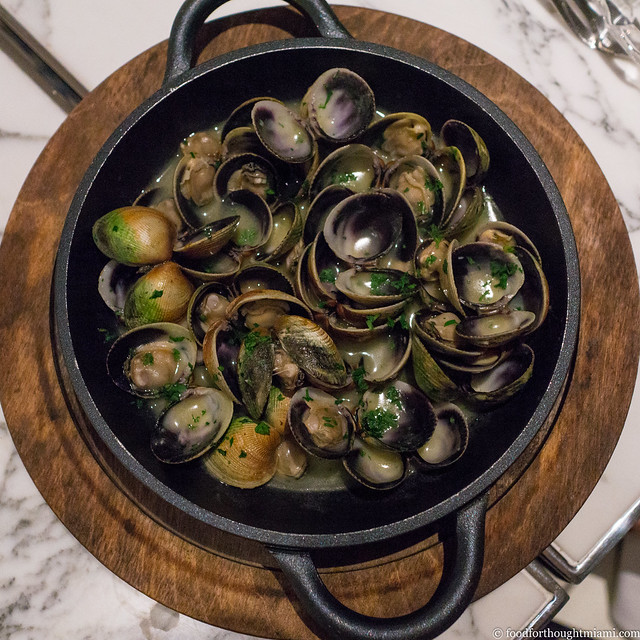 |
| cockles, pil pil sauce - Bazaar Mar |
The larger dishes on the menu tend to skew a bit more traditional, but that doesn't necessarily mean boring. I loved these little cockles, fresh from the tank, in a Basque-style pil pil sauce, an emulsion of garlic, parsley, olive oil and fish juices.
José Andrés' accomplishments this past year far transcend the restaurant world: through World Central Kitchen, he delivered over two million meals to over seventy locations in Puerto Rico after Hurricane Maria devastated the island. He also continues to run restaurants that make some great food. José for President!
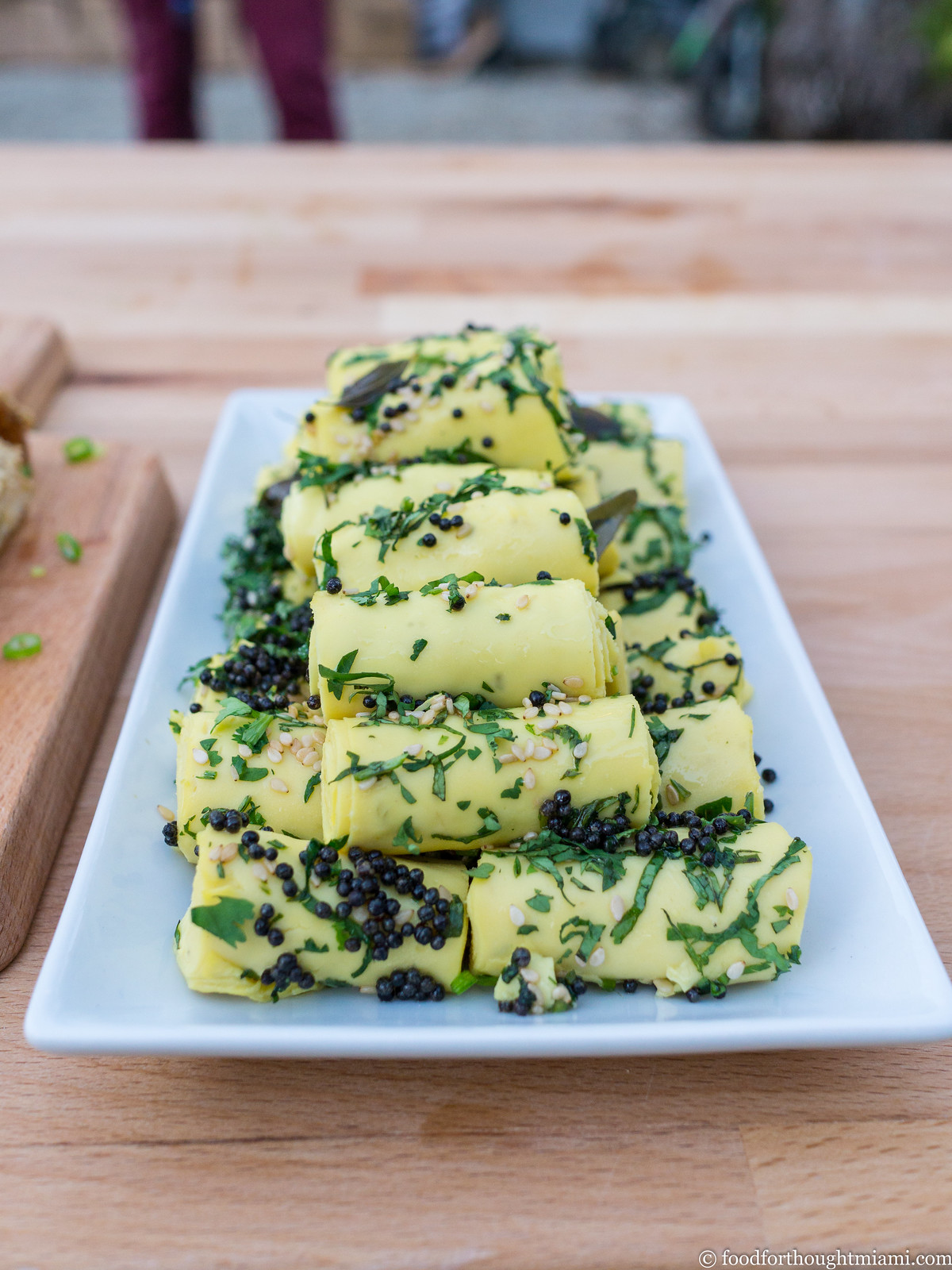 |
| khandvi - Ghee Rancho Patel Cobaya dinner |
A special treat: khandvi, or as our menu called them, "chickpea roll-ups." This was something I'd never tried before, and for good reason: Niven says you're unlikely to ever see these unless your mother or grandmother is making them, as getting the batter – a mixture of chickpea flour and yogurt or buttermilk – and texture right is a bit of alchemy that could keep molecular gastronomists busy for a while. I was glad someone knew how to do it: these light, fluffy crepes, reminiscent of Japanese tamagoyaki, and seasoned with toasted black mustard seeds, julienned cilantro and curry leaf, were absolutely delicious.
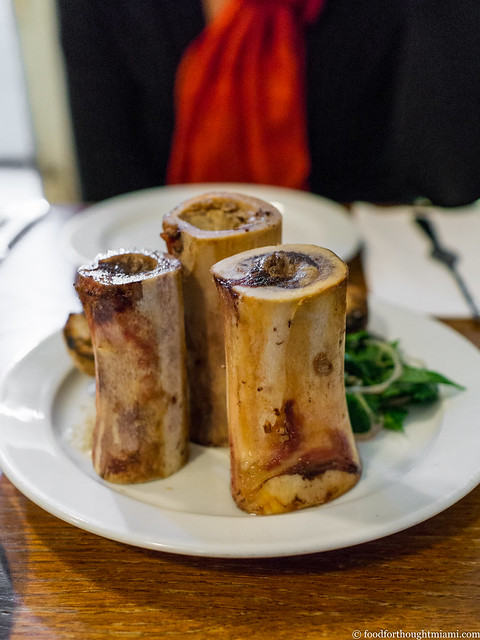 |
| roast bone marrow - St. John Bread and Wine |
Of course, you have to start with the roasted marrow bones – Henderson's most famous dish, one that has been lovingly duplicated countless times in countless restaurants around the world, one that Anthony Bourdain declared his "always and forever choice" for his Death Row meal. The formula is now well-known: roasted femur bones; toasted bread; a pile of parsley salad; a mound of coarse sea salt. Scoop the oozy marrow from the bone, spread on to the toast, dress with a sprinkle of salt and a pinch of the salad, and enjoy. I've had it dozens of times, but never until now the original. And yes, it's the best: the marrow at the magic borderline between solid and liquid, the acid and salt and herbaceous bite of the salad right on the edge of too aggressive without crossing the line, with just the right punch of caper and shallot. I can't say it better than Fergus himself:
"Do you recall eating Raisin Bran for breakfast? The raisin-to-bran-flake ratio was always a huge anxiety, to a point, sometimes, that one was tempted to add extra raisins, which inevitably resulted in too many raisins, and one lost that pleasure of discovering the occasional sweet chewiness in contrast to the branny crunch. When administering such things as capers, it is very good to remember Raisin Bran."
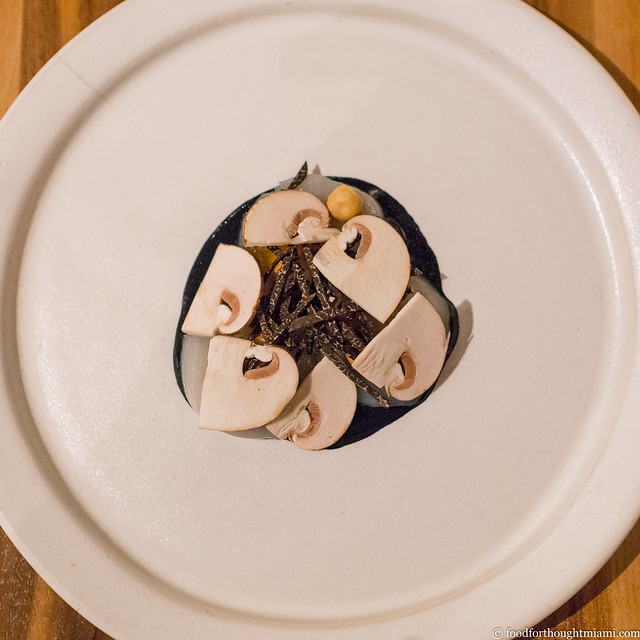 |
| raw Orkney scallop, hazelnut, clementine, winter truffle - The Clove Club |
In "The Physiology of Taste," Brillat-Savarin famously wrote, "The discovery of a new dish confers more happiness on humanity than the discovery of a new star." I can't say for certain that this is an entirely new dish; I can say it's the first time I've had this particular combination of raw scallop, slivered raw button mushrooms, crushed hazelnuts, clementine and black truffle, all assembled over a jet-black squid ink purée. The scallop itself – from fisheries in Orkney, in the outer northern reaches of Scotland – is beautifully plump and fresh and sweet. It's complemented by a fascinating interplay of earthy and nutty flavors, brightened just a hint by the citrus. Speaking for myself, anyway, it's a lot more exciting than the latest "cold brown dwarf."
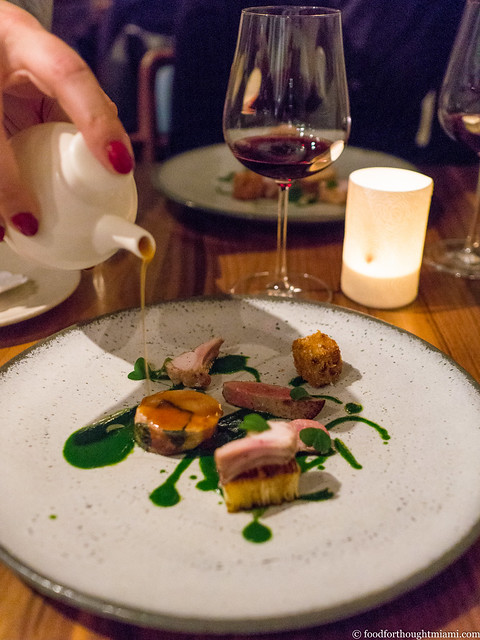 |
| rabbit, celeriac, smoked bacon, tarragon - The Clove Club |
(continued ...)
Wednesday, October 18, 2017
é by José Andrés | Las Vegas
There's a phenomenon on social media lately that whenever a celebrity chef expresses an opinion on political or social issues, a chorus of those whose sensibilities diverge insist that the chef should "stay in their lane." In other words, talk about food all you want, but keep your politics to yourself. The reaction seems inherently ridiculous to me – if you don't like it, the "unfollow" button is a simple, elegant solution – and hypocritical. Unless, that is, all these "stay in your lane" folks are actually career political scientists themselves, or perhaps professional life coaches.
I bring this up here because Chef José Andrés is a powerful retort to that kind of nonsense, someone whose talk has been backed up by meaningful, thoughtful action. The day after Hurricane Harvey cleared Texas, he was in Houston feeding people. A month later when Hurricane Maria decimated Puerto Rico, he was there within days serving meals. Over the past weeks, he's mobilized a brigade of food trucks and canteen kitchens to serve 100,000 meals a day, while getting minimal support from the federal government, in a territory with an almost entirely broken infrastructure.[1]
But this shouldn't come as a surprise. His charity work is not simply a reaction to recent events, but a commitment that dates back to at least 2010, when he founded a non-profit, World Central Kitchen, as a response to a devastating earthquake in Haiti. When, in mid-2016, then-candidate Trump described Mexicans as criminals and rapists, Andrés – an immigrant and naturalized U.S. citizen himself – didn't just gripe about it on Twitter. He pulled out of a multi-million dollar restaurant deal at a Trump property in DC, risking the inevitable lawsuit from the litigation-happy candidate. (Andrés countersued, and the case settled in April on undisclosed terms.)
All of which is to say: José Andrés can cruise in any lane he wants, as far as I'm concerned.
While the work he's doing now in Puerto Rico is infinitely more important, those lanes do actually include chef and restaurateur as well. Andrés' restaurants include the Michelin two-star Minibar, along with a mini-empire of places in DC, LA, Miami, and Las Vegas, the last of which I visited recently for a conference.[2] While there, I squeezed in a dinner at é by José Andrés, an 8-seat "restaurant within a restaurant" inside Jaleo at the Cosmopolitan.
(You can see all my pictures in this é by José Andrés - Las Vegas flickr set).
The format of é is patterned after the original iteration of Minibar in DC with a dollop of Vegas glitz. Its roughly 20-course tasting menu is unabashedly inspired by the creations of Andrés' mentor, Ferran Adrià, with whom Andrés worked at El Bulli in Spain before going on to tremendous success in the U.S. I'd visited é once before, though I hadn't realized how long ago it had been – nearly six years. The room, centered by a polished metal chef's counter surrounded by walls lined with tiny drawers and odd tchotchkes, hasn't changed much. One of the chefs said it was meant to make you feel like "You're inside Chef Andrés' head." (It kind of does.) The menu was almost entirely different, though there were some echoes of prior meals.
Guests are corralled at a table in Jaleo and offered a drink before the dinner at é starts. After a few minutes, the hostess divulges that the centerpiece on the table is also the first course: a cracker flavored with black olive, stuck with edible flowers.
Then upon entering the cloistered dining room, a cocktail: sangria, frozen and powdered to a slushie-like consistency, with compressed melon, sour cherry pearls, and fresh mint leaves.[3]
A cheese course of sorts: a soft-frozen manchego and beet rose topping a walnut cracker, "stones" of idiazabal cheese with a jamón and rosemary glaze nestled atop a bowl of river stones; and a "pizza" of San Simon cheese topped with oregano cream, dried tomato, and fresh shaved truffle.
(continued ...)
Sunday, June 11, 2017
The Clove Club | London
We only had three nights in London on this last trip, our first visit in a decade, but I think our dinner choices – Rules, St. John, and on our final night, The Clove Club – successfully captured a meaningful cross-section. Each of these places might seem quite different on the surface – the red velvet banquettes and gold-framed portraits of Rules are entirely unlike the abbatoir-like black-and-white starkness of St. John, which is equally unlike the cool modernism of the Clove Club. Though the spare, contemporary plates at Clove Club might appear to be from a different world than the straightforward, traditional dishes at Rules, there's a thread which runs through them: a deeply ingrained dedication to British ingredients.
The Clove Club, which started as a living room supper club run by chef Isaac McHale, has made itself a home in a 150-year old building that used to be the Shoreditch Town Hall. Now, you enter into a smart, cozy bar – where, it should be noted, several smaller dishes from the tasting menu are available on an a la carte basis, something I'll be keeping in mind the next time in town. You pass from the bar into an equally smart dining room, the centerpiece of which is a shiny open kitchen. Sometimes these layouts feel like a stage, where the diners are meant to gaze in rapt wonder upon the chefs. This one feels more like the loft of your tasteful London friend, the one with a fetish for blue subway tile and 1960's Scandinavian furniture. It's elegant, in an understated way; but more important, it's comfortable – it still feels like it could be a living room supper club, though in a pretty fancy living room.
Dinner can be either a five-course affair, currently priced at £75, or a more elaborate tasting menu for £110, which was the route we chose.
(You can see all my pictures in this The Clove Club - London flickr set; these are from a meal in February 2017).
The meal starts with a series of snacks, the first of which is something of a signature dish: buttermilk-marinated fried chicken, dusted with pine salt, and presented nestled in a woven basket filled with pine branches. It is like the platonic ideal of a chicken nugget. A glass of Gusbourne Blanc de Blanc accompanies the snacks, and I'm pleasantly surprised to discover that very respectable sparkling wine is coming from this side of the English Channel, in West Sussex.
McHale turns his sights to his native Scotland next with a warm haggis bun, the funk of offal tempered by warm spices and a dusting of vinegar powder. Local ingredients take a Japanese turn with a rectangular laver (seaweed)[1] crisp that serves as the vehicle for a rich, oily mackerel tartare.
(continued ...)
Monday, April 3, 2017
Rules Restaurant | London
Fergus Henderson may have helped convince the world that British food was worthy of attention with his restaurant, St. John (some more thoughts on St. John here). But at Rules, they were never in any doubt.
Rules bills itself as the oldest restaurant in London. Over the past two centuries, it's been owned by only three families: Thomas Rule opened it in 1798; just before World War I, one of his descendants decided to move to France, and arranged a swap with a Brit running a restaurant in Paris named Tom Bell; and then in 1984, Bell's daughter sold the restaurant to its current owner John Mayhew.
The dining room, with its red velvet-wrapped, gold-piped banquettes, polished wood dividers, oil portraits and old cartoons on the walls,[1] the occasional marble bust here and there, looks every bit the part. If not for the bona fides of its history, the stereotypically posh decorations would seem almost laughable. I adore the place.
We first came here on a family trip to London more than ten years ago. Our daughter was about six years old at the time; she did not adjust well to the jet lag, and within an hour she was sliding under the table.[2] This time around, I was the one who wanted to throw a fit when I learned that we had just missed game season. Through the present owner's inheritance of the Lartington Estate in northern England and relationships with local game dealers, Rules sometimes has a glorious assortment of wild things on the menu – its "famous grouse," but also woodcock, pheasant, partridge, wild duck, hare and more. Alas, not on this visit.
(You can see all my pictures in this Rules - London flickr set).
Before getting to the food, I highly recommend a visit upstairs to the Edward VII Room, a/k/a the cocktail bar, a snug spot with a carved wooden bar counter, a few tables and couches, and a fine assortment of hunting murals and trophies adorning the walls. The bar program is run by Mike Cook, and his crew can handily make the classics like a pitch-perfect Negroni. But they also have their own creations, like the intensely aromatic Lucia Sciarra, named after a character from the last James Bond film, Spectre.[3]
Once I'd recovered from having missed game season (my recovery aided by a pleasant cocktail), I focused my attention on the menu, which also helped ease my disappointment. You get the sense it could have been written a hundred years ago. Chef David Stafford shows occasional flashes of whimsy, like a duck leg "pastilla" paired with a spiced duck breast, but for the most part he proudly and lovingly cooks traditional British dishes. And this he does exceedingly well.
So there's potted shrimps, a mound of tiny, tender brown crustaceans caught in Morecambe Bay, preserved in butter and spices in the way it's been done for hundreds of years. There's Middlewhite pork terrine, which makes use of a rare heritage breed of pig that originated in Yorkshire, served simply with picallili and cornichons. The shrimp taste of shrimp, the pork tastes of pork, and I couldn't possibly be happier.
For her main, Mrs. F chooses the Uig Lodge smoked salmon, sourced from a smokery on the far northern reaches of the Outer Hebrides. The salmon is served with fat slabs of brown bread and offered either with or without scrambled eggs, but surely this is a rhetorical question? The salt and smoke on the fish whisper rather than shout, and its texture is all silk, matched by the soft, creamy eggs.
For me, a real taste of tradition: a steamed suet pudding. It arrives at the table completely unadorned, looking like a doorstop from a giant's castle. Cut it open, and beneath a layer of dense, chewy suet pastry, a stew of venison, red wine and chestnut mushrooms issues forth. There's nothing light or delicate here, but it has a brawny beauty all its own; it's rich, and hearty, and sticky, and satisfying, and I love that such things still exist in this world.
Along with our mains, we have some bronze-crested, buttery-interiored potatoes Anna, as well as a perky salad with sprightly pale sprigs of frisée, crispy bacon lardons, toasty croutons and a bracing shallot vinaigrette.[4]
We always enjoy ending a meal with some good cheeses, but Mrs. F is not so much a fan of the blue-veined varieties. So I'm pleased to hear that the cheese plate, which features a few English cheeses served with biscuits and a sweet shallot jam, can be supplemented with a portion of the Cropwell Bishop Stilton. The entire wheel is brought to the table, from which they will scoop the paste onto your plate until you say "enough!" Made by a third-generation creamery in Nottingham, it's more creamy than crumbly, tangy enough to balance the fat but not so much to blow out your sinuses, and just lovely stuff.
There's a certain danger in a place like this getting weighed down by its historical baggage, but Rules manages to avoid that. It doesn't feel, or taste, like a museum piece, but rather like a living, breathing restaurant that just happens to be from another century. But good food is timeless; I hope Rules remains so as well.
Rules Restaurant
35 Maiden Lane, Covent Garden, London, England
+44 0 20 7836 5314
[1] There's also a massive mural on one wall of a stern-faced Margaret Thatcher looking as if she belongs on the prow of a ship.
[2] She didn't actively misbehave. She just sort of ran out of steam, started to fade and get a little teary-eyed, and quietly mewled "I'm broken." We still say this when it gets a little too late in the evening for any of us.
[3] The concoction includes Star of Bombay Gin, Lillet Blanc, Benedictine, Gammel Dansk Bitter Dram, and a lemon twist. You can see Cook making one here. Delicious. You can also see Rules make a cameo appearance in a scene from Spectre which was shot at the restaurant. Rules has made many other literary appearances, including in novels by Evelyn Waugh and Graham Greene, among others. Speaking of things literary, I think it's just wonderful that the restaurant proudly republishes an absolutely scathing review by Kingsley Amis entitled "Where Disaster Rules," written sometime in the 1970's, on their website ("There are cheaper eating-places than Rules where the atmosphere and service are so pleasant that they drive out other impressions. Far from the case here; but then I find it hard to imagine an establishment Elysian enough to dispel the memory of two of the most disgusting full-dress meals I have ever tried to eat in my life.")
[4] We also drink a really nice wine, the 2010 Rossignol-Fevrier "Robardelle," a premier cru vineyard in Volnay from a producer which I don't think gets distributed in the U.S. Happily, the wine list at Rules mostly shares my predilections for Burgundies, Rhones, and sub-$100 wines.
[2] She didn't actively misbehave. She just sort of ran out of steam, started to fade and get a little teary-eyed, and quietly mewled "I'm broken." We still say this when it gets a little too late in the evening for any of us.
[3] The concoction includes Star of Bombay Gin, Lillet Blanc, Benedictine, Gammel Dansk Bitter Dram, and a lemon twist. You can see Cook making one here. Delicious. You can also see Rules make a cameo appearance in a scene from Spectre which was shot at the restaurant. Rules has made many other literary appearances, including in novels by Evelyn Waugh and Graham Greene, among others. Speaking of things literary, I think it's just wonderful that the restaurant proudly republishes an absolutely scathing review by Kingsley Amis entitled "Where Disaster Rules," written sometime in the 1970's, on their website ("There are cheaper eating-places than Rules where the atmosphere and service are so pleasant that they drive out other impressions. Far from the case here; but then I find it hard to imagine an establishment Elysian enough to dispel the memory of two of the most disgusting full-dress meals I have ever tried to eat in my life.")
[4] We also drink a really nice wine, the 2010 Rossignol-Fevrier "Robardelle," a premier cru vineyard in Volnay from a producer which I don't think gets distributed in the U.S. Happily, the wine list at Rules mostly shares my predilections for Burgundies, Rhones, and sub-$100 wines.
Saturday, April 1, 2017
St. John Bread and Wine | London
Until recently, British food has been saddled with a terrible reputation. I'm reminded of the old George Carlin joke about heaven and hell:
"In heaven, the Italians are the lovers, the French cook the food, the Swiss run the hotels, the Germans are the mechanics, and the English are the police. In hell, the Swiss are the lovers, the English cook the food, the French run the hotels, the Italians are the mechanics, and the Germans are the police."
That reputation, I've always thought, has been undeserved. Even thirty years ago, when I spent a summer in Oxford "studying," I ate very well. Ploughman's lunches with good cheese and bread, rich steak and kidney pies, crisp, steamy fish and chips wrapped in newspaper, fiery Indian and Jamaican food – what's not to like?
Over the past couple decades, general sentiment seems to have shifted, and now London is regarded as one of the world's top dining destinations. Partly that's been driven by international attention for this very moneyed, lucrative market; one of the odd things about planning a recent brief visit to both London and Paris (three days in each) was realizing that many of Paris' top chefs have opened outlets in London so that, in Epcot-like fashion, you could arguably taste some of the best of Paris without ever crossing the Channel. But even more so, it's been driven by English chefs' internal reflection: recognizing, and promoting, great British cookery.
One of the individuals who was formative in that shift was Fergus Henderson. His restaurant, St. John, which opened in 1995, and his cookbook, first published in 1999 as "Nose to Tail Eating: A Kind of British Cooking" (released in the U.S. in 2004 as "The Whole Beast: Nose to Tail Eating") are mostly recognized for being a manifesto on the joys of offal and whole-animal utilization. They are most definitely that, but they also are an ode to traditional British dishes – things like cock-a-leekie soup and bath chaps and game birds and Eccles cakes – and the value of native ingredients.
I'd never been. So it was the first dinner reservation I made for this trip.
We actually booked at St. John Bread and Wine, a sibling to the original St. John around the corner from Smithfield Market. Bread and Wine, originally intended to be a bakery and wine shop (thus the name), makes its home across from the Spitalfields Market,[1] and is slightly more casual than the mothership. More of the menu is offered as small plates, and they ascribe to the "dishes come out as they're ready and are meant for sharing" school of service. Since this gave us an opportunity to sample broadly, it was perfect.
(You can see all my pictures in this St. John Bread and Wine flickr set).
Of course, you have to start with the roasted marrow bones – Henderson's most famous dish, one that has been lovingly duplicated countless times in countless restaurants around the world, one that Anthony Bourdain declared his "always and forever choice" for his Death Row meal. The formula is now well-known: roasted femur bones; toasted bread; a pile of parsley salad; a mound of coarse sea salt. Scoop the oozy marrow from the bone, spread on to the toast, dress with a sprinkle of salt and a pinch of the salad, and enjoy. I've had it dozens of times, but never until now the original. And yes, it's the best: the marrow at the magic borderline between solid and liquid, the acid and salt and herbaceous bite of the salad right on the edge of too aggressive without crossing the line, with just the right punch of caper and shallot. I can't say it better than Fergus himself:
"Do you recall eating Raisin Bran for breakfast? The raisin-to-bran-flake ratio was always a huge anxiety, to a point, sometimes, that one was tempted to add extra raisins, which inevitably resulted in too many raisins, and one lost that pleasure of discovering the occasional sweet chewiness in contrast to the branny crunch. When administering such things as capers, it is very good to remember Raisin Bran."Though not as famous, the other dishes we tried exhibited the same winning combination of good, honest ingredients, intense, robust flavors, and attentive execution.
I loved these tender curls of lamb's tongues wrapped around cubes of bread, all enrobed in a bright, verdant green sauce, like a meaty panzanella salad. Picking at a smoked fish nearly always brings me joy, and the minimalist approach here – the unadorned back end of a smoked mackerel, served simply on a plate with a potato salad given a sinus-clearing blast of mustard dressing – is my kind of happy meal.
Another testament to the joy of simplicity: slabs of toast spackled with a rich, intense mousse of duck livers and foie gras. It's just nearly too much; then you take a bite of cornichon, your appetite is restored, and you go back for more. The smoked cod's roe is like salt, smoke and sea wrapped in silk, but maybe the best part are the crispy batons fashioned from thin layers of potato perched on top. We finished with deviled kidneys: chewy, soft, springy, and ferrous, served over toast drenched with cooking juices spiked with mustard powder and Worcestershire sauce.[2]
We ordered dessert whilst draining the last of a bottle of Beaujolais, starting first with St. John's version of a classic – Eccles cake. There are whole families of traditional British desserts of which I know nothing, this being a good example. Every time I'd peruse the online menu at St. John I'd see it, and so of course I had to order it. The sweetness of the "cake" – a flaky pastry wrapped around a filling of sticky currants – is balanced by an accompanying slab of fresh, crumbly, sharp, faintly salty Lancashire cheese. Then a few minutes later, a batch of warm, airy madeleines, fresh from the oven. We trusted our server for something to drink with these, and our trust was rewarded with a glass of Pineau de Charentes.
Honestly, I wondered if St. John would live up to its nearly mythical reputation. Bourdain, in his foreword to the U.S. release of Nose to Tail, acknowledges, "My enthusiastic rant in my book A Cook's Tour made him sound like George Washington, Ho Chi Minh, Lord Nelson, Orson Welles, Pablo Picasso, and Abbie Hoffman – all rolled into one." And Henderson, both in interviews and on the page, evinces such unbridled enthusiasm, humble charm, and subtle wit that it's hard to imagine not liking his food. This is a man who can make curly parsley sound good![3]
But this was just a joyous meal: great ingredients; straightforward, bold, intense flavors; presented without any fanfare but prepared with subtle finesse. In my version of heaven, Fergus is welcome to cook the food.
St. John Bread and Wine
94-96 Commercial Street, London
020 7251 0848
[1] While Smithfield is still a functioning meat market, Spitalfields has been refurbished into a shopping mall.
[2] I rarely get to eat kidneys, and even more rarely get to eat properly prepared kidneys, but even so, their sort of crumbly, bouncy texture still puts them fairly low on my Favorite Offal list. Tripe, or livers, or sweetbreads, or hearts, would all rank before kidneys in my book.
[3] "As the swish, swish, swish of bunches of flat Italian parsley is to be heard in kitchens across the land, it seems time to celebrate the strength and character of the indigenous curly parsley. Its expression of chlorophyll and well being, strong flavor, slightly prickly texture, and its structural abilities enable such things as Parsley Sauce."
[2] I rarely get to eat kidneys, and even more rarely get to eat properly prepared kidneys, but even so, their sort of crumbly, bouncy texture still puts them fairly low on my Favorite Offal list. Tripe, or livers, or sweetbreads, or hearts, would all rank before kidneys in my book.
[3] "As the swish, swish, swish of bunches of flat Italian parsley is to be heard in kitchens across the land, it seems time to celebrate the strength and character of the indigenous curly parsley. Its expression of chlorophyll and well being, strong flavor, slightly prickly texture, and its structural abilities enable such things as Parsley Sauce."
Saturday, December 31, 2016
best dishes of 2016: part 3
We're coming in for a landing here – the final segment of my Best Dishes of 2016 (you can read Part 1 and Part 2 here).
(You can see pictures of all of them in this Best Dishes of 2016 flickr set).
Let me start here with the kind of superlative I'm usually loathe to state: Brad Kilgore's Alter was my favorite restaurant of the year, and for my money, the best restaurant in Miami right now (read my thoughts and see all my pictures from Alter). Brad's cooking is creative, smart, beautiful, lush without being overly heavy, and most important of all, flat out delicious.
Now a year and a half in, he's not afraid to change things up either. The dishes that appear here were from the last lunch service at Alter on October 1 (partly a result, I have to imagine, of the attention drawn by Brad's newest project, Brava at the Arsht Center). Then last month, Alter quietly switched its dinner service to a predominantly tasting-menu format, with either a 5-course $69 or 7-course $89 options, and only a very abbreviated list of a la carte alternatives. And now another new piece, just added in the past few days: a more casual a la carte menu for the no-reservations outdoor bar area.
A recent twitter exchange hit on a nugget of truth: more often than not, when a dish is "revisited" or "reinvented" (or worse, "deconstructed"), the end result pales in comparison to the original.
The classic Spanish snack, pan con tumaca (a/k/a pan con tomate or pa amb tomàquet), is a simple thing: grilled or toasted bread, rubbed with raw garlic and tomato, drizzled with olive oil, and sprinkled with salt. And yet with the right ingredients – crusty bread, ripe juicy tomato, fruity peppery olive oil – it is magically good, and difficult to improve upon.
The version I had this weekend at Alter, though, manages it. A thin plank of sourdough, golden on its surface but with still a whisper of tenderness at its center. A daub of tomato butter, warmed with Aleppo pepper. Soft, crushed cherry tomatoes, bleeding their juices. Slivers of pickled garlic, as thin as Paulie cut in prison. Red vein sorrel – pretty, sure, but also providing a bit of grassy, tart contrast.
The same lunch featured another successful "reinvention" – this incredibly luxurious version of brandade. The base of the dish was a rich, Robuchon-esque potato purée, enriched with local burrata (presumably from Mimmo's Mozzarella), and topped with flakes of silky smoked black cod, crisp puffed potatoes, and sweet-savory onion jam.
One of my all-time favorite meals was a visit to Blaine Wetzel's Willows Inn, off the coast of Washington State on tiny Lummi Island. I was thrilled to have an opportunity to make a return visit in October (read my thoughts and see all my pictures from Willows Inn). Sometimes those magical experiences are like lightning in a bottle, never to be captured again. But the second time was every bit as good, maybe better, than the first. Wetzel is a special chef and this is a special place.
There's nothing particularly showy or ostentatious about chef Blaine Wetzel's cooking. Quite the opposite, he willingly sets his ego aside and let the ingredients take center stage. That's not to diminish the skill with which he handles the wonderful things he finds in this little corner of the world, but rather to say that he really knows how to tell a story of time and place through a meal, eschewing unnecessary embellishment in favor of clarity.
An old favorite: a fragile, crisp crepe shell encasing steelhead roe and a maple cream, capped with finely snipped chives on the ends. This is just perfect.
Followed by a new (for me), perfect bite: puffy, savory doughnuts, filled with silky smoked black cod, and sprinkled with sea salt and dried seaweed. I could eat a dozen of these.
With the sun setting over the Rosario Strait outside, there was another burst of color at our table: what Wetzel calls an herb tostada. The "tostada" is a mustard green leaf, fried in a delicate tempura style batter. It's spread with an oyster and herb emulsion, and then then topped with an assortment of vividly flavored leaves and flowers: nasturtium, shiso, basil, mint, brassica flowers, and more. It's incredibly delicate but intensely flavored, with each bite yielding a different surprise. This is a beautiful, wonderful dish.
One final thought. If you go to Willows Inn, you'll likely stay at Willows Inn, and if you stay at Willows Inn, a word of advice: don't skip breakfast. It is outstanding. Served family style, the lineup varies from day to day. Ours started with some fresh, luridly magenta-hued plum juice, served in a coupe glass, followed by some local doughnut peaches with creamy fresh yogurt topped with toasted hazelnut butter. Then a really glorious breakfast smorgasbord: a runny soft boiled egg; a pile of buckwheat crepes; fat slices of gravlax with fresh farmer cheese; house-smoked bacon, pancetta, and an aged, spice-rubbed cheese; kale wilted in flaxseed oil with coarse salt; sweet plum jam, tangy late-season rhubarb compote, silky fig custard drizzled with honey; a fat slab of creamy butter. Assemble as you wish. I can't imagine a better send-off.
Myumi is not your typical sushi bar (read my thoughts and see all my pictures from Myumi). In fact, it's a truck – a converted FedEx delivery truck, currently stationed in a lot in Wynwood. From that truck, they serve an omakase only (chef's choice) menu with only two choices: do you want to spend $40 or $60? The omakase-only format means they know exactly what they need to buy, so they buy some very good stuff: fish and shellfish straight in from Japan, uni and ikura from Alaska, tuna from Ecuador. Some items get just a brush of shoyu, others more elaborate garnishes.
Maybe my favorite bite from my last visit was this nigiri of aji, the pleasantly oily, fatty fishiness of the minced horse mackerel counterbalanced by the zing of ginger and scallion, then topped with toasted sesame seeds.
(continued ...)
(You can see pictures of all of them in this Best Dishes of 2016 flickr set).
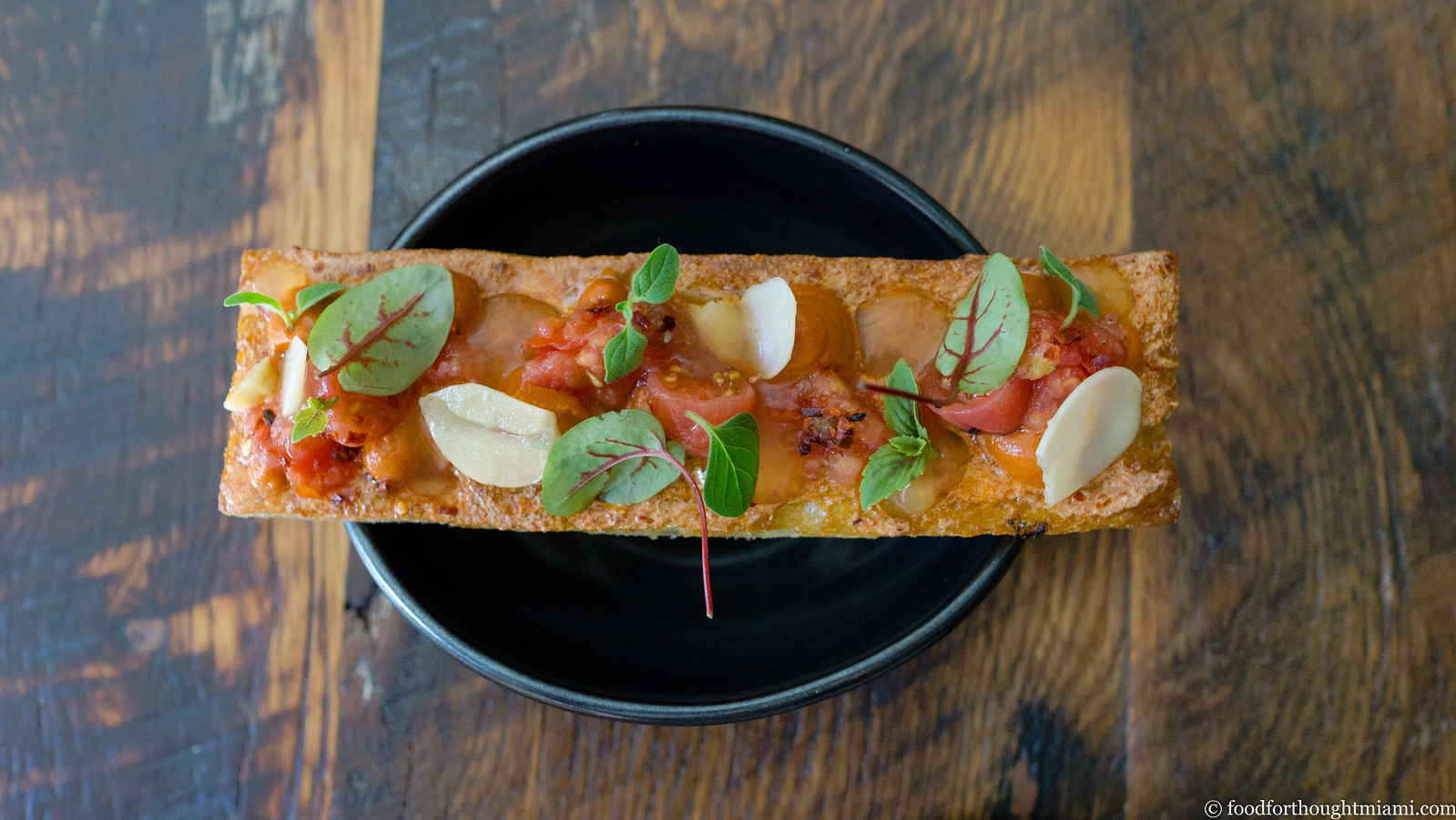 |
| pan con tumaca - Alter |
Now a year and a half in, he's not afraid to change things up either. The dishes that appear here were from the last lunch service at Alter on October 1 (partly a result, I have to imagine, of the attention drawn by Brad's newest project, Brava at the Arsht Center). Then last month, Alter quietly switched its dinner service to a predominantly tasting-menu format, with either a 5-course $69 or 7-course $89 options, and only a very abbreviated list of a la carte alternatives. And now another new piece, just added in the past few days: a more casual a la carte menu for the no-reservations outdoor bar area.
A recent twitter exchange hit on a nugget of truth: more often than not, when a dish is "revisited" or "reinvented" (or worse, "deconstructed"), the end result pales in comparison to the original.
The classic Spanish snack, pan con tumaca (a/k/a pan con tomate or pa amb tomàquet), is a simple thing: grilled or toasted bread, rubbed with raw garlic and tomato, drizzled with olive oil, and sprinkled with salt. And yet with the right ingredients – crusty bread, ripe juicy tomato, fruity peppery olive oil – it is magically good, and difficult to improve upon.
The version I had this weekend at Alter, though, manages it. A thin plank of sourdough, golden on its surface but with still a whisper of tenderness at its center. A daub of tomato butter, warmed with Aleppo pepper. Soft, crushed cherry tomatoes, bleeding their juices. Slivers of pickled garlic, as thin as Paulie cut in prison. Red vein sorrel – pretty, sure, but also providing a bit of grassy, tart contrast.
 |
| potato purée, smoked cod - Alter |
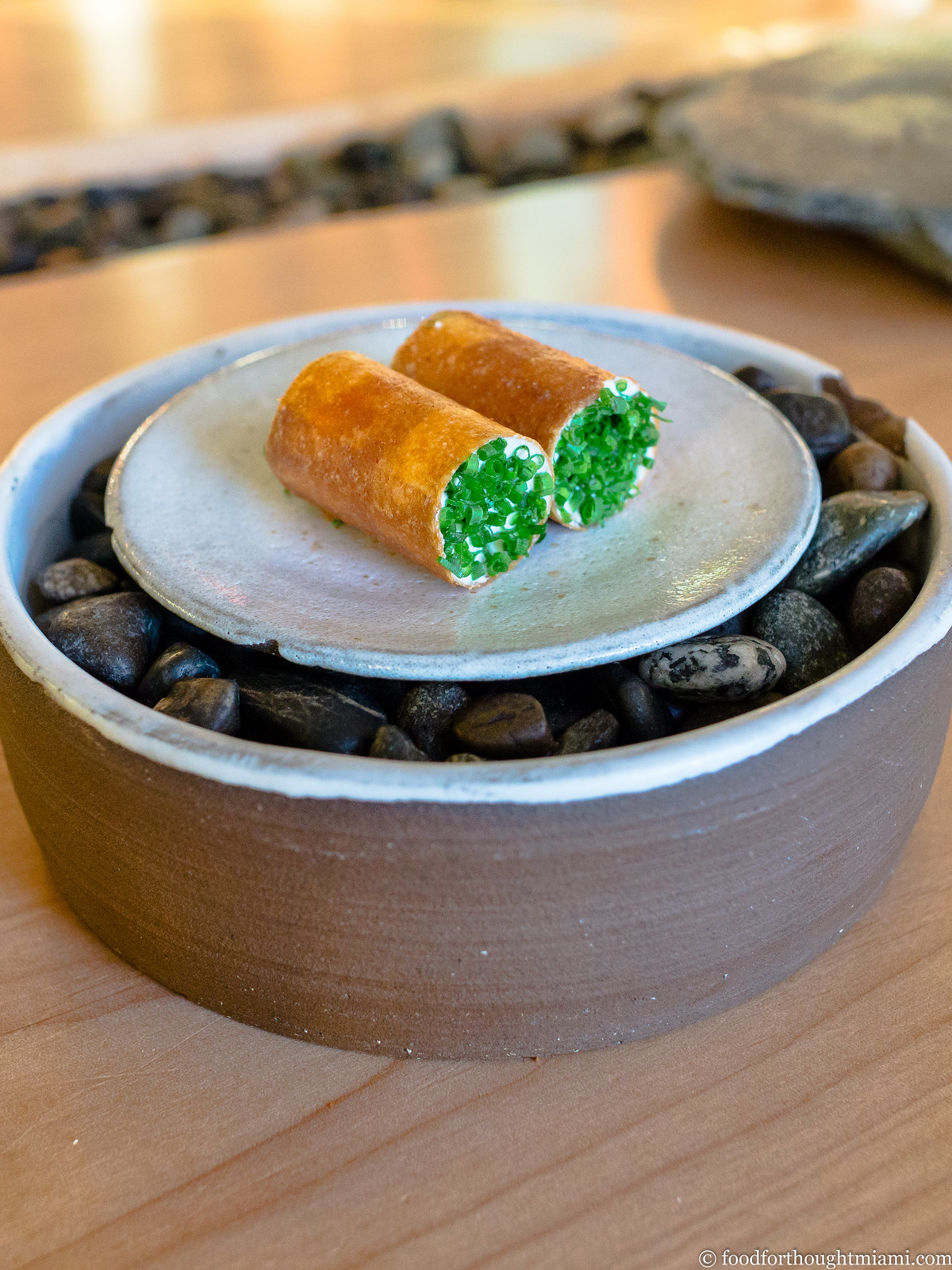 |
| steelhead roe, maple cream, chive, crispy crepe - Willows Inn |
There's nothing particularly showy or ostentatious about chef Blaine Wetzel's cooking. Quite the opposite, he willingly sets his ego aside and let the ingredients take center stage. That's not to diminish the skill with which he handles the wonderful things he finds in this little corner of the world, but rather to say that he really knows how to tell a story of time and place through a meal, eschewing unnecessary embellishment in favor of clarity.
An old favorite: a fragile, crisp crepe shell encasing steelhead roe and a maple cream, capped with finely snipped chives on the ends. This is just perfect.
 |
| smoked black cod doughnuts - Willows Inn |
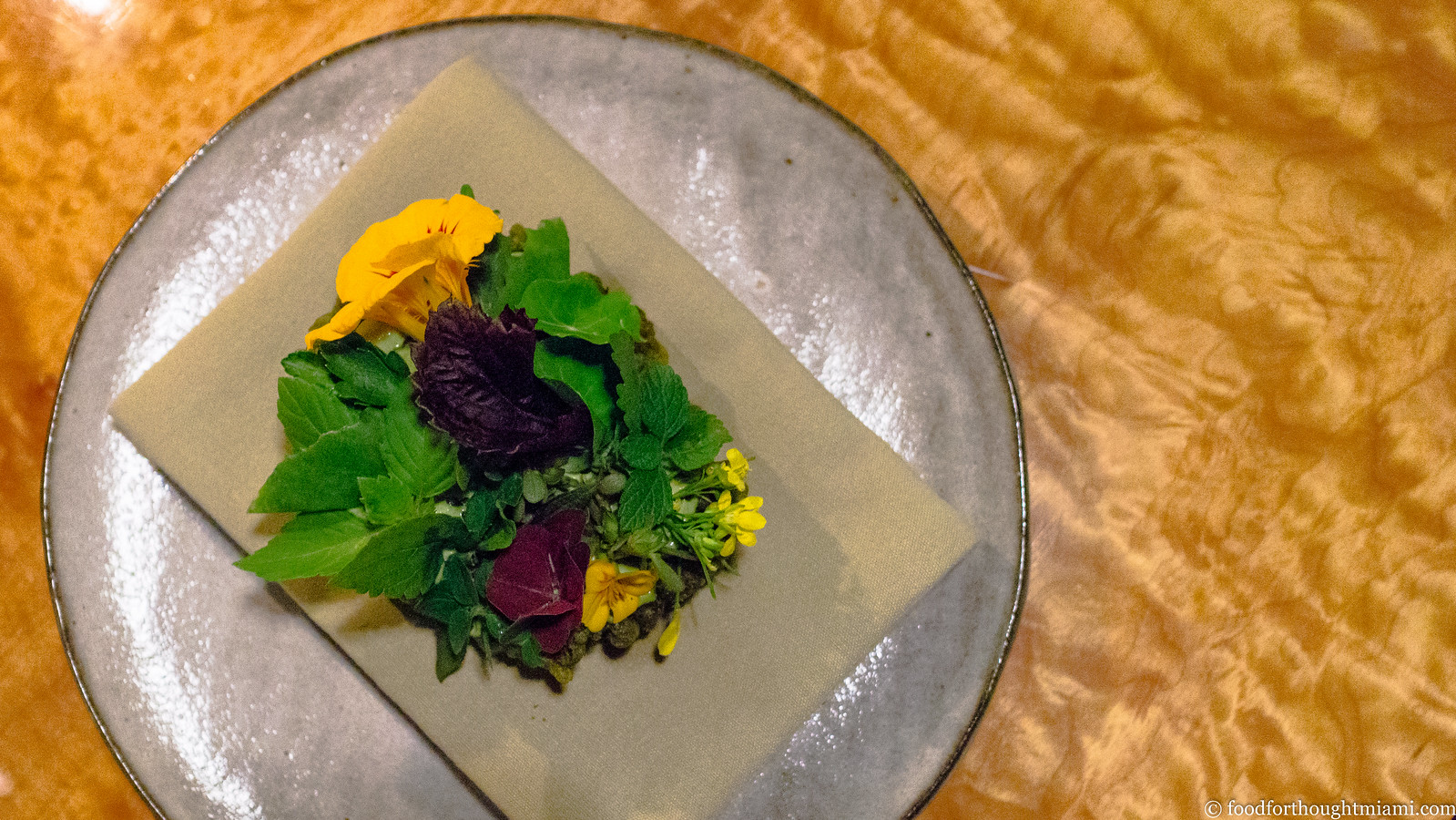 |
| herb tostada - Willows Inn |
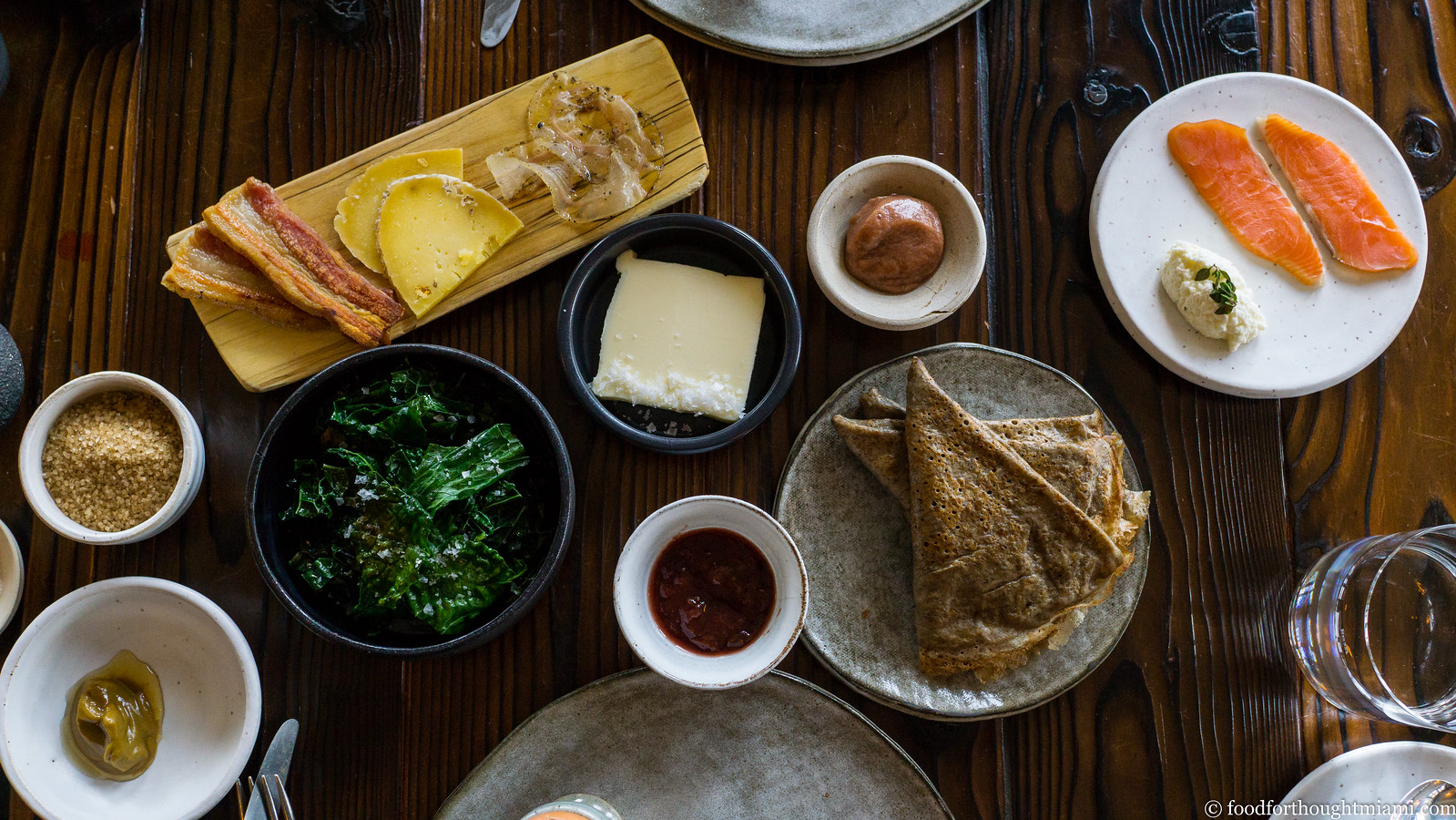 |
| breakfast spread - Willows Inn |
 |
| aji chopped with ginger and scallion - Myumi |
Maybe my favorite bite from my last visit was this nigiri of aji, the pleasantly oily, fatty fishiness of the minced horse mackerel counterbalanced by the zing of ginger and scallion, then topped with toasted sesame seeds.
(continued ...)
Subscribe to:
Posts (Atom)


